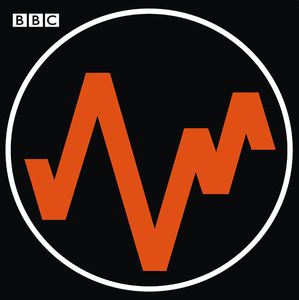Contents
Specially Created
Commission Impossibles
From time to time the BBC Sound Effects Centre (SEC) would commission sound effects for their ever-growing catalogue from their colleagues, the BBC Radiophonic Workshop (RWS). In most cases, these were sounds it was not possible to capture in or outside a studio. The weather was a prime target. Being naturally unreliable, planning a recording session would be impossible.
Uncreditted – Were Credits Due?
The RWS were not credited as such for their contributions though, with the exception of ‘Radiophonic Stomach’, which was Bloodnok’s stomach anyway (and even this was more of a gastro-intestinal thing, as I understand it). No effects from any source were actually credited as it was recognised that there was no authorship to a sound recording. This limitation extended to sounds created artificially, although exceptions such as the aforementioned stomach existed. And, it must be said, the copyright of the recording was and remains with the BBC. Although their effects are free for amateur use, any commercial use requires licensing.
Cross Referencing
How then, am I to track down these radiophonic sound effects? Firstly, the RWS tape archive holds many of the answers. They kept their own collection of tapes and a list of them has been available on Ray White’s site for many years. https://whitefiles.org/rwx/rwslib.pdf. I’ve referred to it throughout this review it is an invaluable resource. This file lists many tapes as being made for the SEC. It does not however list the SEC disc number. For that, I need to look in my copy of the 1985 BBC SEC Sound Effects Catalogue, with some cross-referencing with the list of effects for sale from the BBC by Pro Sound Effects (PSE). I can also reference these to the BBC Rewind Sound Effects site, so that you can hear them via that site too.
Special Sound, Specially Created
One kind of clue that an effect was created at the RWS is that the SEC catalogue adds the note “specially created”, in paratheses, to some effects. This is not a guarantee of RWS involvement, however. Effects were created especially for all sorts of programmes (although a lot came from The Goon Show). This designation is seemingly applied to sounds which were generated by some artificial means, rather than recorded solely by sticking a microphone near something real.
Sounds Electronic
Another clue that there might be a Radiophonic provenance to an effect is simply that the sound is electronic. Effects in the Electronic Sounds category of the SEC catalogue can either be a field recording of an electronic device – for example, the hum of a refrigerator – or, ‘specially created’. The special sounds (oh yes) can be further split into three categories: entirely invented for a fantastical or fictional object, such as “Plasma Gun”; simulated, such as weather effects (as we’ll see below); or some that could be either real or as close to real as makes no difference. An example of this type might be bleeps meant to sound like a computer. That computers rarely really made these sounds (there’s a whole essay in this) or that the precise way the sound was synthesized was not how it would happen in a computer (another, shorter but more boring essay) is not important. In these cases, it depends on what you want the sound effect to represent. If it’s to represent a sine wave generator then the selection of sine waves on EC 192J is practically a field recording (unless the speaker it’s coming from and the room it is played in matters a lot). If it’s some other reason you need a sine wave, then the effect is being used artificially.
All of that is to say that if you wanted a sound that was created in a lab it might be because you have a lab to represent or because you wanted something that could not be recorded in the field. And, of course, the electronic sound laboratory that was the RWS was the clear choice when looking for synthetic sounds.
Nothing Special
As noted elsewhere in this blog, the RWS was gradually becoming obsolete as a source of electronic sounds throughout the 70s and 80s. If the RWS tape archive list is to be believed then the last effect provided to the SEC was in 1973. After that, it is probable that such synthesized sound effects could be obtained from other places or by other BBC studio engineers and managers with the necessary gear. There’s a strong example of this below. It’s also possible that the RWS was just too busy to be bothered with the SEC after a certain point. Equally, the SEC may have grabbed effects from existing RWS tapes. This might be the case as there is a tape in the archive simply called ‘effects’. This was a stock of useful sounds compiled together for easy access. There’s every reason to suppose that the SEC would have filched this stock selection and made use of them. I also suspect that as the RWS staff got their copyright act together and because they were being paid for their effects on BBC Records LPs and cassettes they were less keen on giving things away to the SEC for free.
Category Error
Finally, there are a couple of RWS archive tapes which state that they are for the SEC, but which defy easy categorization. As you’ll see, these are not therefore possible to locate as SEC effects discs. Yet!
Effective Dates
I’ve listed the effects below in TRW (Tape Radiophonic Workshop) number order, which is broadly chronological. These can correlate with the broadcasts they were created for, although some seem to have been compiled later for the SEC. Discs were created by the SEC on a different schedule altogether. Dates given for aneffects’ creation need not match when the discs were put into the catalogue. Precise dates for that are not available either. There is a table at the end where I list all the discs covered there in the order they were made, using the matrix numbers. as the index.
Radiophonic Workshop Archive Tapes
Bayeux Tapestry Effects – Delia Derbyshire
First up is a tape (TRW No. 6557) of effects culled from the radio programme A Bayeux Tapestry (TRW No. 6442). That programme tape number includes five reels of effects along with more for speech and the master.
The programme was a tapestry of sound woven together by Delia Derbyshire for producers George Macbeth and someone who would go on to become a long-term Workshop collaborator, Micahel Mason. Their goal was a kind of “total radio” and Derbyshire’s input was essential to not only edit all of the sounds together but also apply ‘treatments’ to voices and create special effects. In particular, a representation of Halley’s Comet was called for. The programme tape was logged in February 1966 and then the effects tape later that year in September – labelled as “For Sound Effects Centre”. The broadcast followed on 13th October 1966.
The Comet Isn’t Coming
The most intriguing part of this tape, from what has been written – and no recording of the programme is in the public domain – is the mention of the comet effect. As they said in the Radio Times, the RWS “enabled…the Comet of 1066 to emit its eerie ‘radio-signal.'”. This “electronic image”, as Mason later called it, is something worth looking for I reckon.
Unsurprisingly, there is no “comet”, Halley’s or otherwise, listed in the SEC catalogue. There are various types of radio signals, but nothing “specially created”. If this cue made it to the SEC it’s well hidden.
1966 And Not All That
Digging through the SEC catalogue for 1966, there is only one disc which flags up an immediate connection with the Bayeux Tapestry. EC 82C. The effects listed below are all dated November 1966.
- Eleventh Century Battle, large army fighting with swords & axes.
- Eleventh Century Battle, general battle atmosphere.
- Eleventh Century Battle, twelve men fighting with swords and axes.
The dates match. Both historical period and Effects recordings. The subject matter is exactly what you’d expect too. This must be from A Bayeux Tapestry.
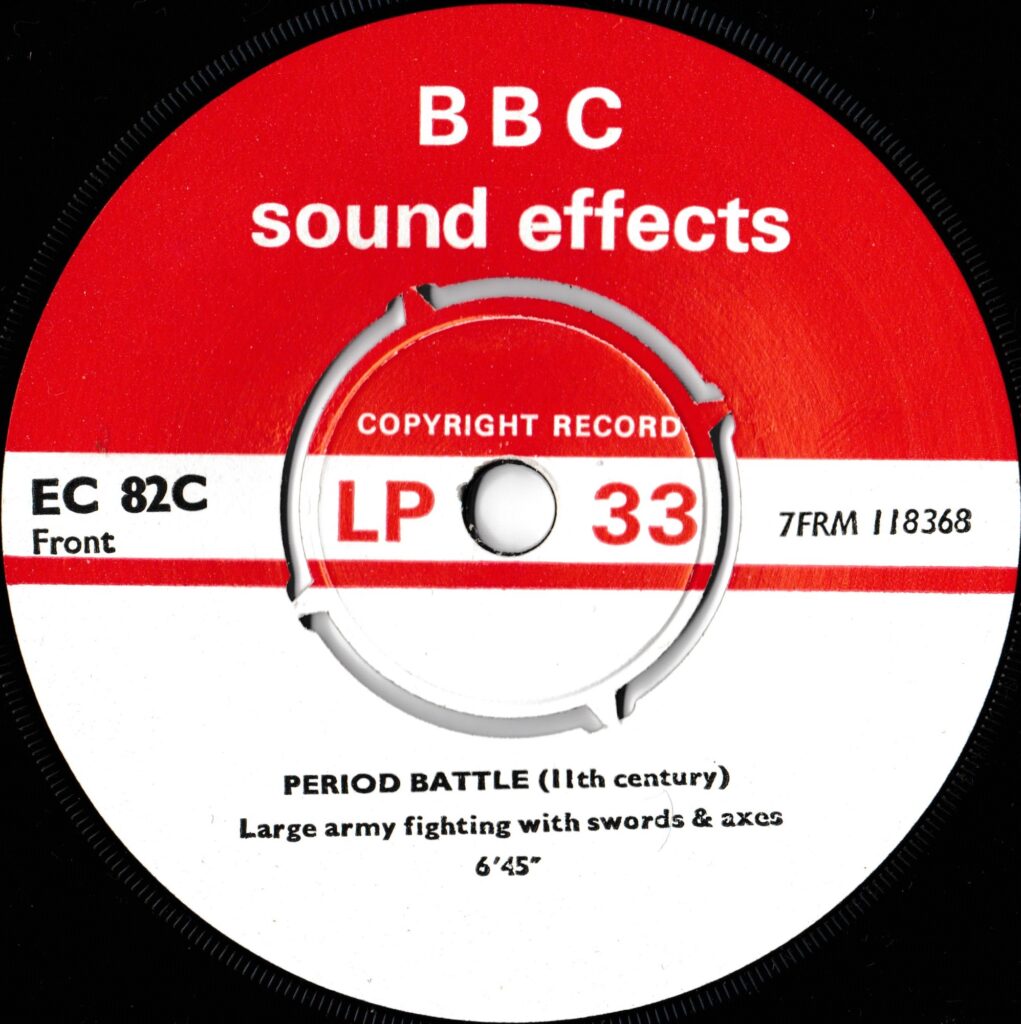
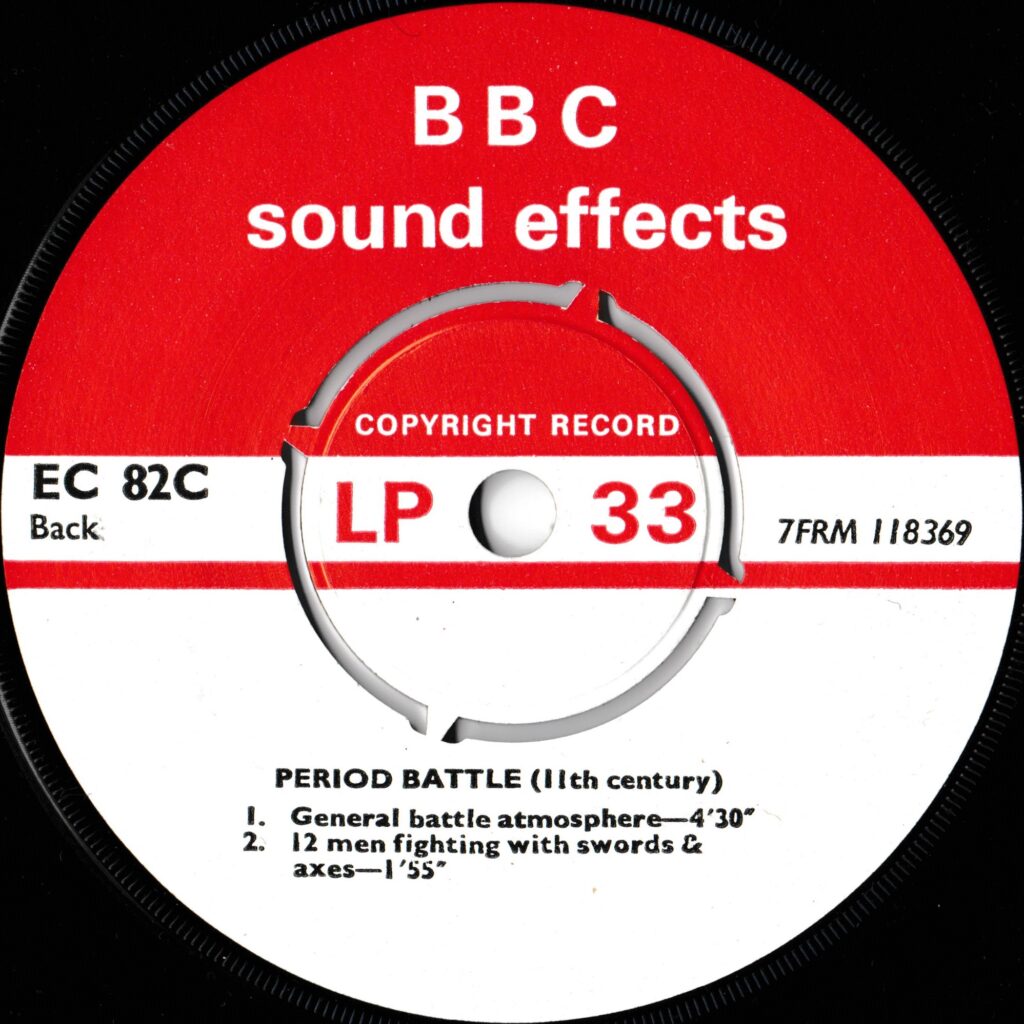
There seems little doubt that this disc is the work of Delia Derbyshire. It’s just, not the most innovative or interesting example of RWS special sound. There might be more, and more exciting, excerpts from this programme scattered around the SEC catalogue, but for now, this is all that is, more or less, confirmed.
If nothing else, it shows that sometimes the greats of the golden age of the RWS were not creating gold, but getting on with some more workaday sound editing.
One final point is that there’s nothing electronically generated about these sounds. There’s tape manipulation, and you can hear the loops, but the sounds are bread-and-butter foley work. The skill here seems to be multiplying one or two men into two whole armies. Using loops of different lengths and perhaps three tape machines
Sea Effects – David Cain
This tape (TRW No. 6688) was created for Harry Morriss (Organiser, Sound Effects) by David Cain in 1967. To be precise it was logged on 1st July 1967.
Looking for this effect in the SEC catalogue initially came up with nothing in ‘Sea’ or ‘Electronic Sounds: Sea’ categories. Looking a little further though led to ‘Electronic Sounds: White Noise’. Here I found two whole discs of sea effects. EC 129A and EC 129B. All effects are dated August 1967. Good enough!
The full descriptions are :
- White noise filtered to simulate sea effects. High frequencies.
- White noise filtered to simulate sea effects. Medium frequencies.
- White noise filtered to simulate sea effects. Low frequencies.
- White noise filtered to simulate sea effects. Ripples.
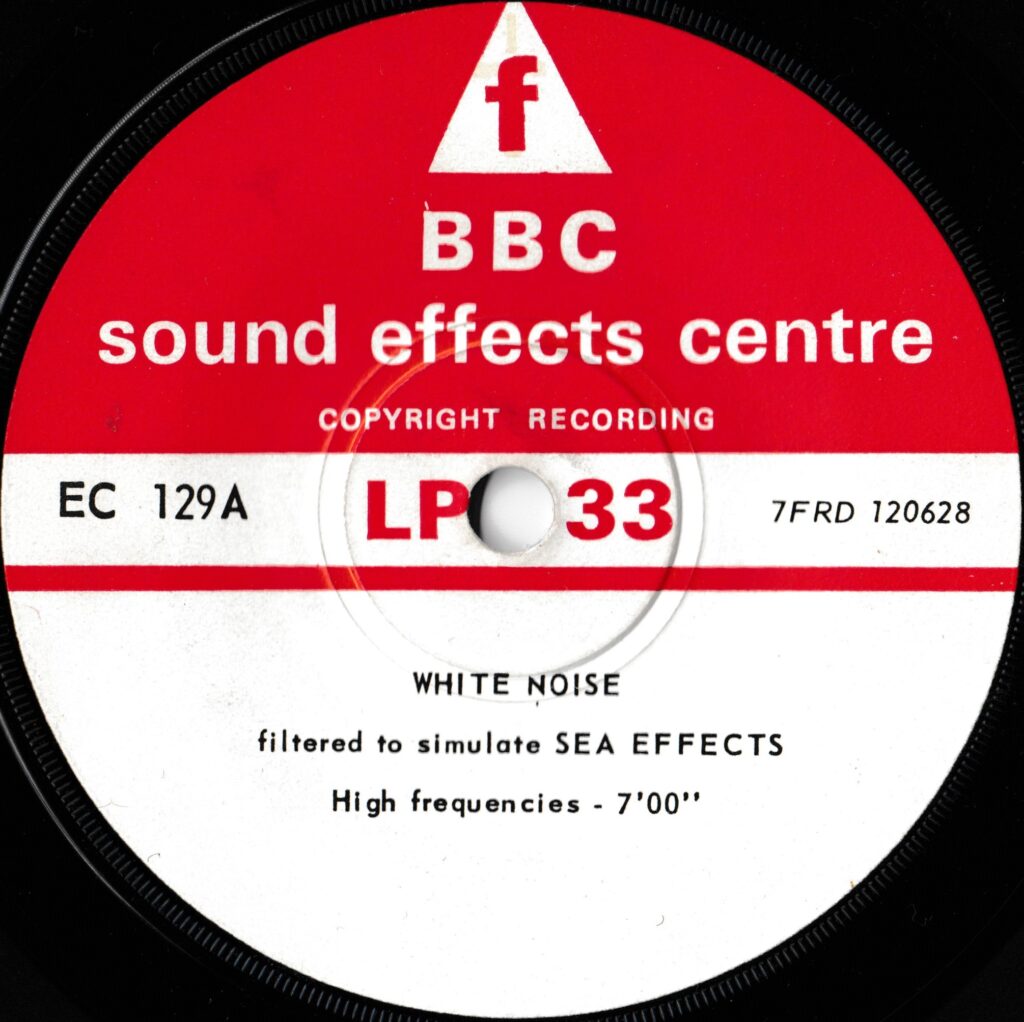
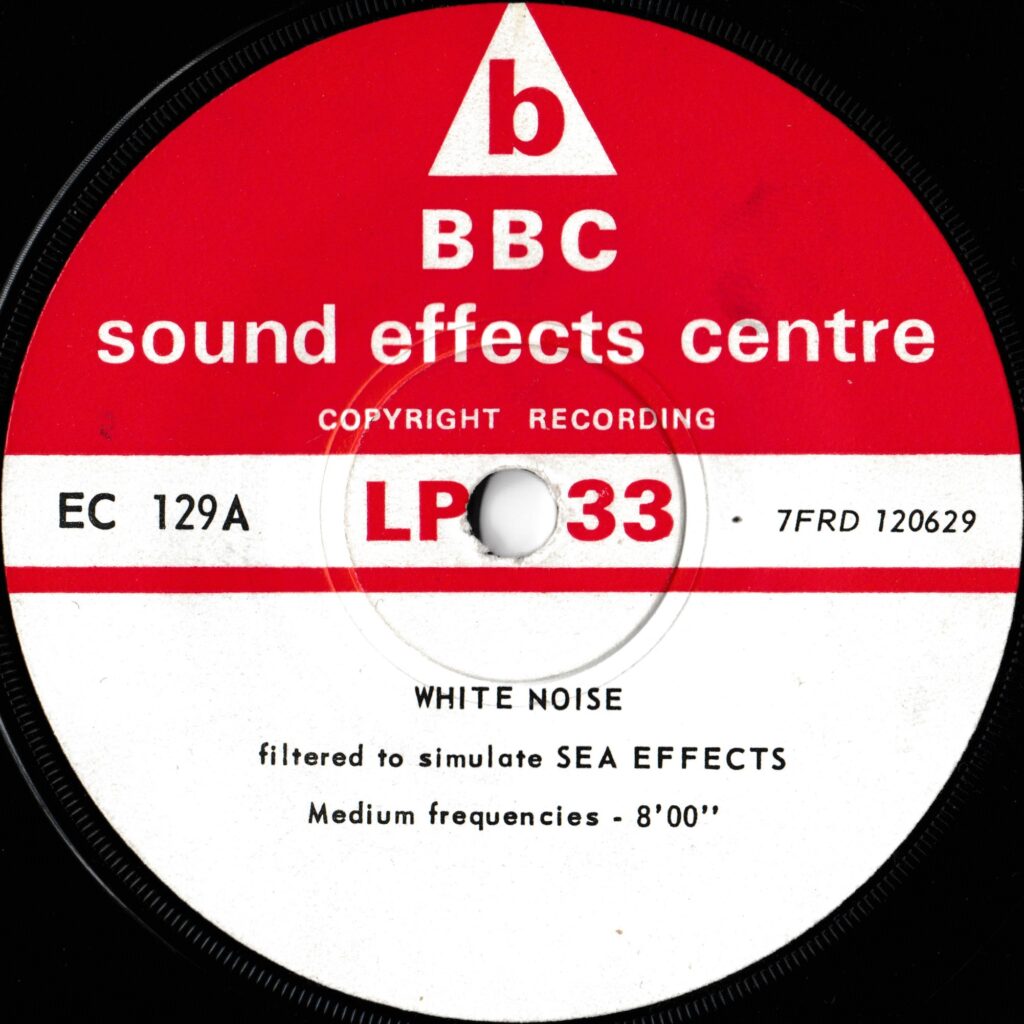

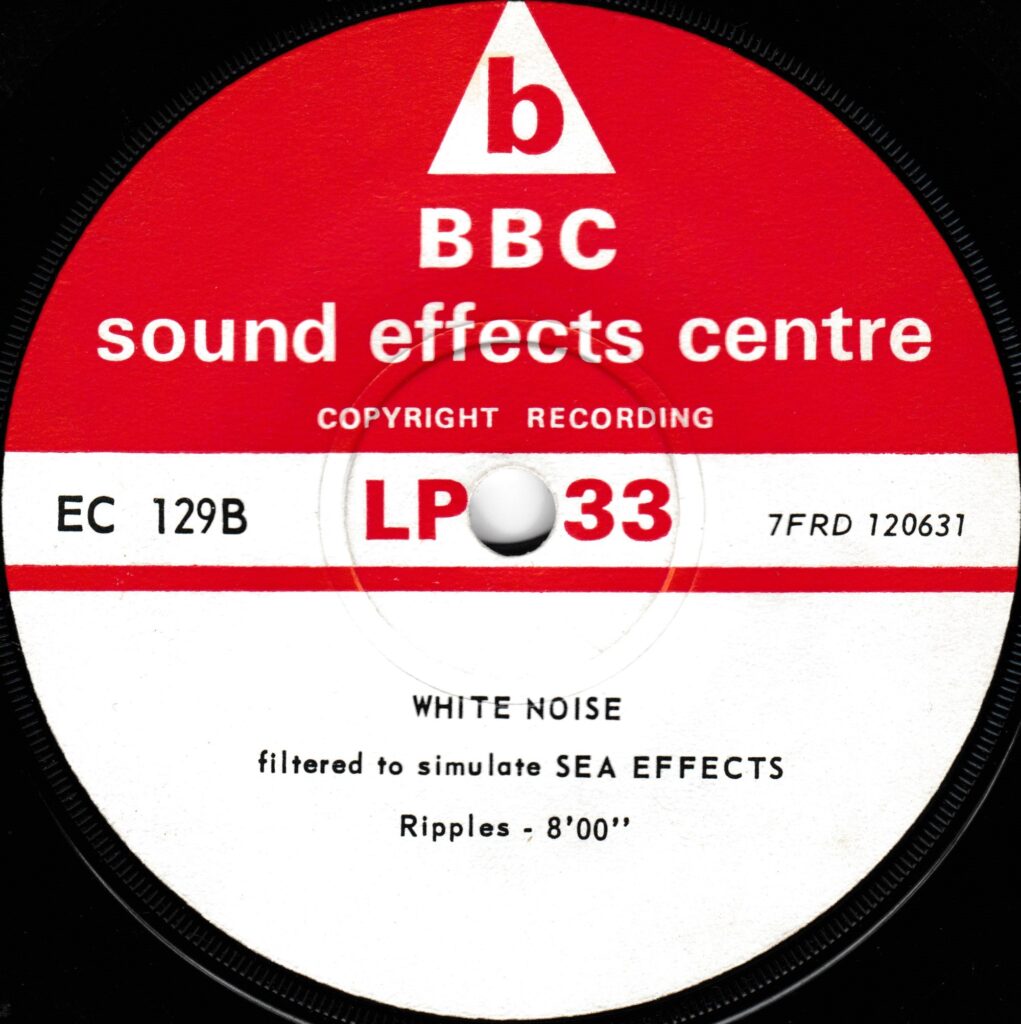
So, we have a pair of verified David Cain records here. Let’s continue with the search!
Thunder – Dick Mills
Also in July 1967 for the Sound Effects Centre’s Harry Morriss (Organiser, Sound Effects) Dick Mills was making heavy weather. This tape (TRW No. 6701) is also dated 1st July.
It might seem like David and Dick we’re getting some easy summer jobs done, but as Cain was also turning in his Radio Sheffield jingle at the same time (“master cutler stuff”), amongst a number of other productions, that is nowhere near the truth. Perhaps a better understanding comes from the fact that Cain started at the workshop in late 1966 and one of his earliest projects was ‘Outlook: The Unconquered Ocean’ (TRW 6573) around November 1966. More accurately this tape is credited to Cain and Mills.
It appears that most likely Dick was dubbing off effects they had already produced. And doesn’t that seem more likely? Looking for likely sources of thunder effects in the tapes, there are more than a few possibilities from his own projects in 1967 alone, including TRW 6660 ‘Black Cloud’ for External Services (Chinese).
In any case, the effects were destined for SEC disc EC 19E. The list below is in the order that they appeared on sound-effects.bbcrewind.co.uk
- Clap of thunder. (Specially created)
- Clap of thunder. (Specially created)
- Clap of thunder. (Specially created)
- Clap of thunder. (Specially created)
- Clap of thunder. (Specially created)
- Clap of thunder. (Specially created)
- Clap of thunder. (Specially created)
- Clap of thunder. (Specially created)
- Clap of thunder. (Specially created)
- Clap of thunder. (Specially created)
- Claps of thunder with rain. (Specially created)
- Claps of thunder with rain. (Specially created)
These were easily located under ‘Weather: Thunder & Rain’ in the SEC catalogue.
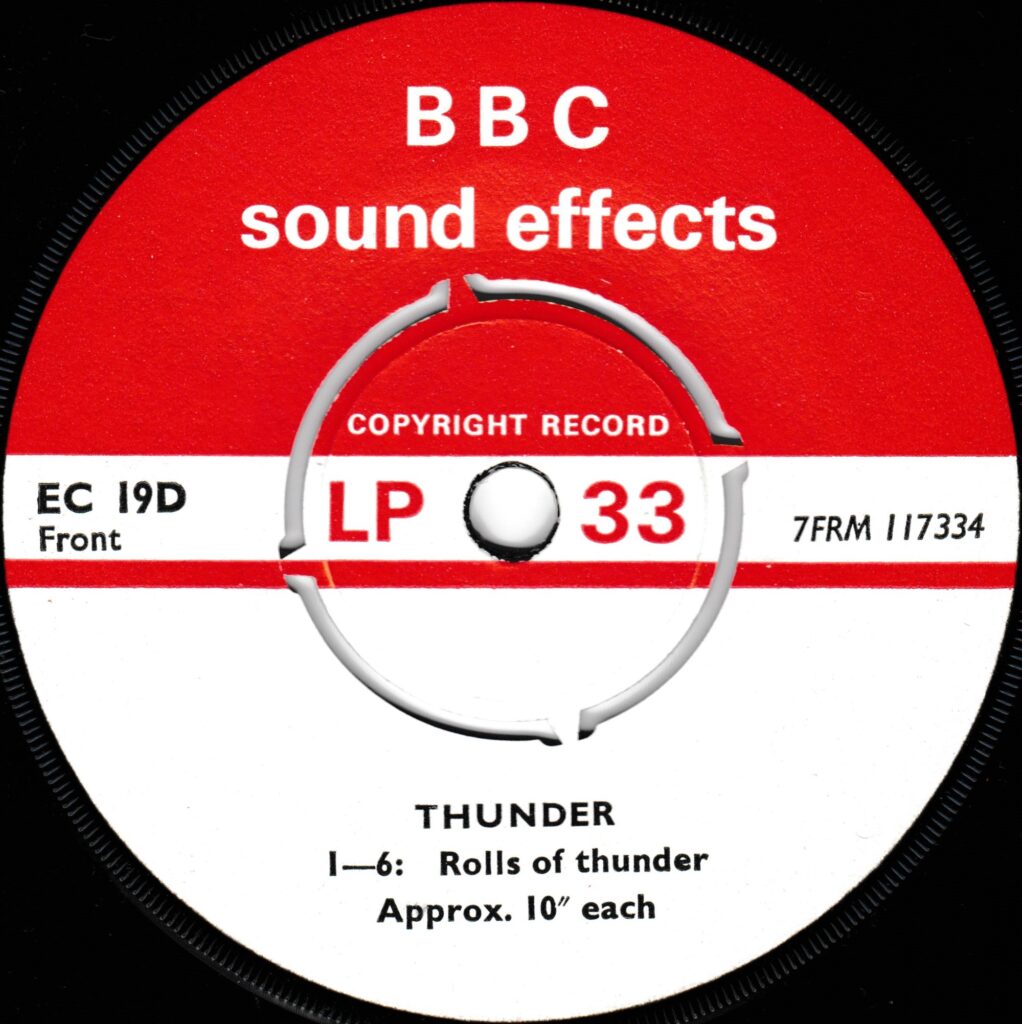
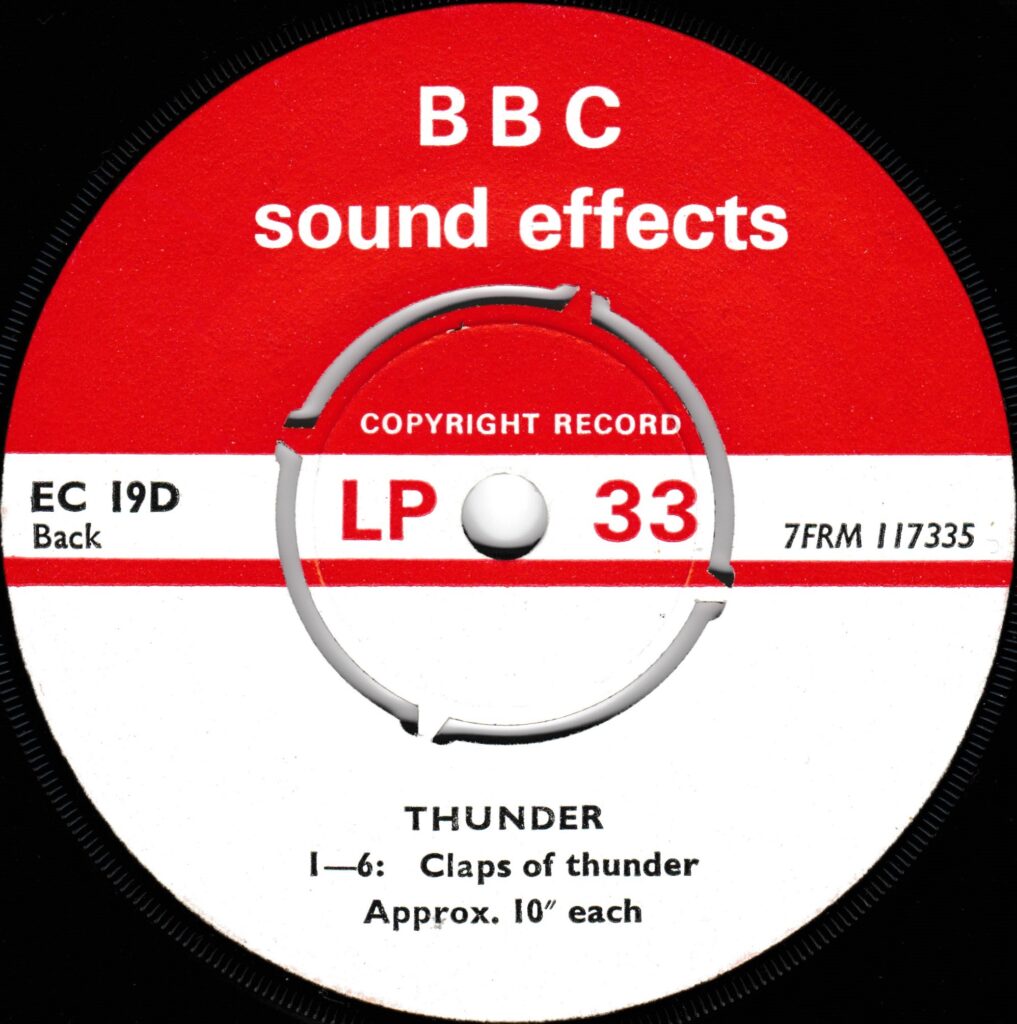
Lightning – Dick Mills
You can’t have thunder without lightning. Described as “Lightning for Sound Effects Centre” for Harry Morriss (Organiser, Sound Effects) this RWS tape (TRW No. 6951) is dated October 1968.
Looking up Lightning in the 1985 SEC Effects catalogue (See Weather: Lightning) I find EC 66F (front), five different 3-second cues called “Simulated Lightning – 1970”. These could be the ones. Even though the dates don’t match up exactly they are close at least.
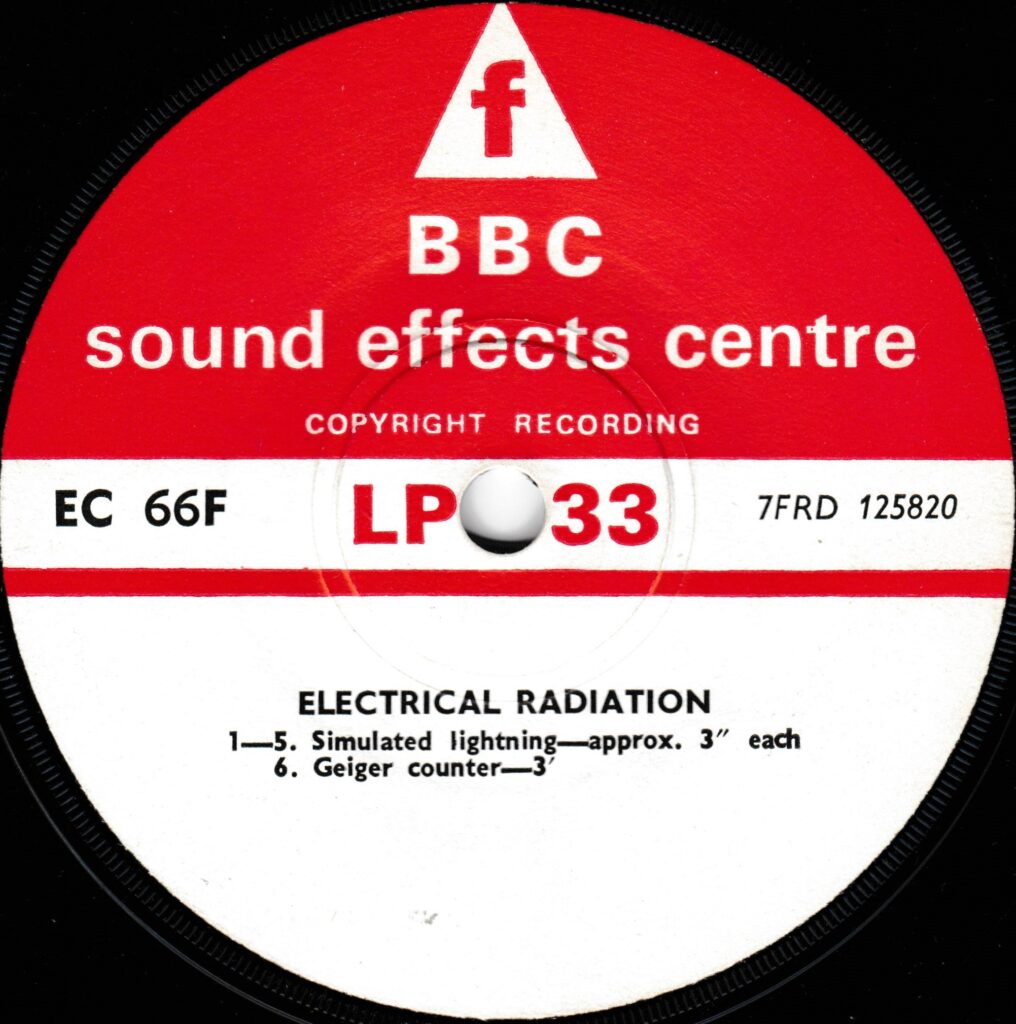
The fives effects are simply numbered 1-5 and can be heard here:
These effects are also listed twice more under the Electronic Sounds category as Lightning and Radiation. This may be a mistake as lightning is actually an electrical discharge, but I’m not here to get into such pedantry.
Under the Electronic Sounds: Radiation section and on the back side, there are listed four cues comprising a Geiger counter, amplifier crackles (from the counter or interference is not clear), “radio interference (radiation)” and a “Wimhurst machine”. The latter is a type of lab equipment used for creating electrostatic and thus sparks. More discharge, not radiation (sorry).
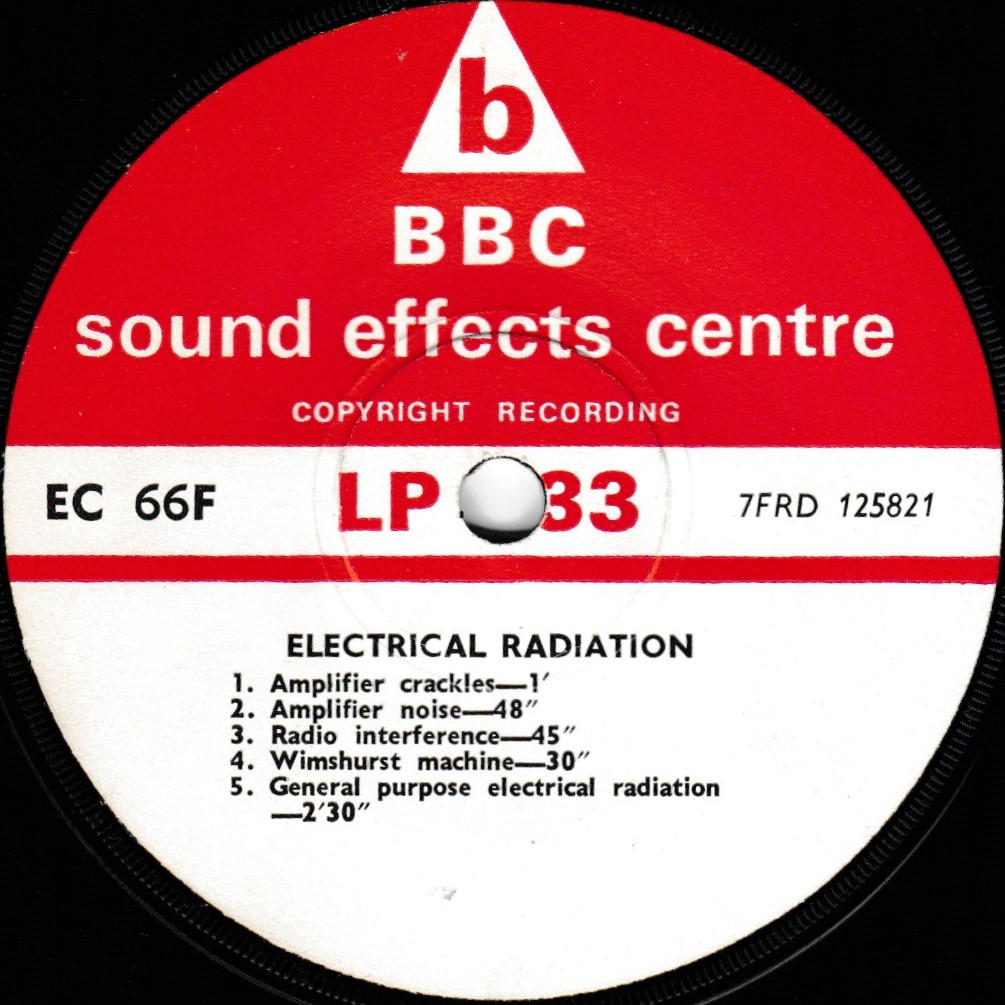
This radiation stuff appears to be sound recordings and all are dated Feb 1970, apart from the Geiger counter. Other EC 66 category effects are of a similar ‘radiation’ type.
Note. These lightning effects are not on the PSE site and are therefore not available to buy.
Wind – Dick Mills
Having shocked the SEC with his lighting the previous month, Dick Mills was back with his ‘Wind for Sound Effects Centre’ at the request of Harry Morris. November 1968 is the date given by the RWS tape archive (TRW No. 6963), but there is another mismatch with the SEC catalogue.
Under the category of ‘Electronic Sounds: White Noise’ are five effects sets listed. Two discs of “sea effects” from 1967 (see above), and three sets of “simulated wind” dated December 1969. That’s a year later than the RWS tape, but even if we don’t think this is a typo, it’s still got to be the same thing, hasn’t it?
Assuming that this is what we’re looking for, there are three discs full of Dick’s finest gusts of air. These are EC 129 D, E and F. The effects are listed as “White noise filtered to simulate wind at constant pitch” and numbered 1-12 with increasing pitches.
- White noise filtered to simulate wind at constant pitch. Wind 1. (Lowest note)
- White noise filtered to simulate wind at constant pitch. Wind 2 (3 tones up from Wind 1)
- White noise filtered to simulate wind at constant pitch. Wind 3 (3 tones up from Wind 2)
- White noise filtered to simulate wind at constant pitch. Wind 4 (3 tones up from Wind 3)
- White noise filtered to simulate wind at constant pitch. Wind 5. (3 tones up from Wind 4)
- White noise filtered to simulate wind at constant pitch. Wind 6. (3 tones up from Wind 5)
- White noise filtered to simulate wind at constant pitch. Wind 7. (3 tones up from Wind 6)
- White noise filtered to simulate wind at constant pitch. Wind 8. (3 tones up from Wind 7)
- White noise filtered to simulate wind at constant pitch. Wind 9. (3 tones up from Wind 8)
- White noise filtered to simulate wind at constant pitch. Wind 10. (3 tones up from Wind 9)
- White noise filtered to simulate wind at constant pitch. Wind 11. (3 tones up from Wind 10)
- White noise filtered to simulate wind at constant pitch. Wind 12. (3 tones up from Wind 11)
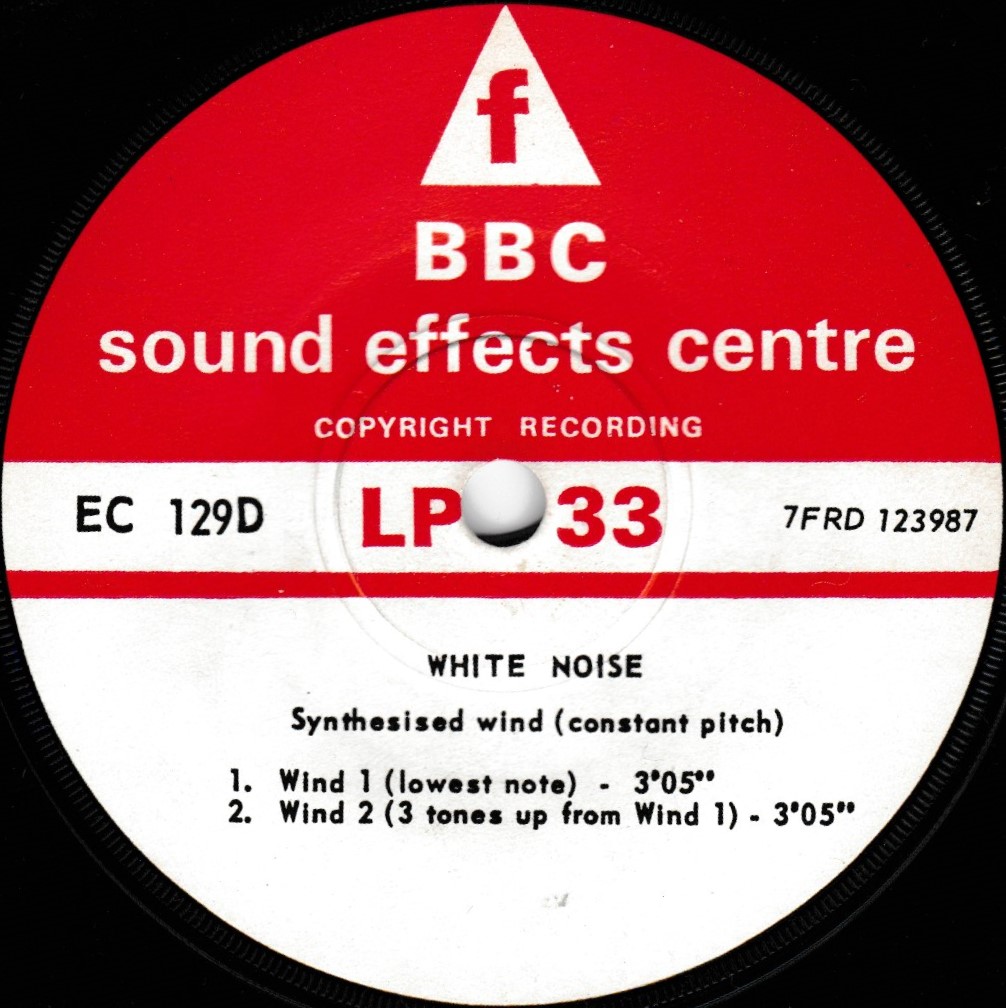
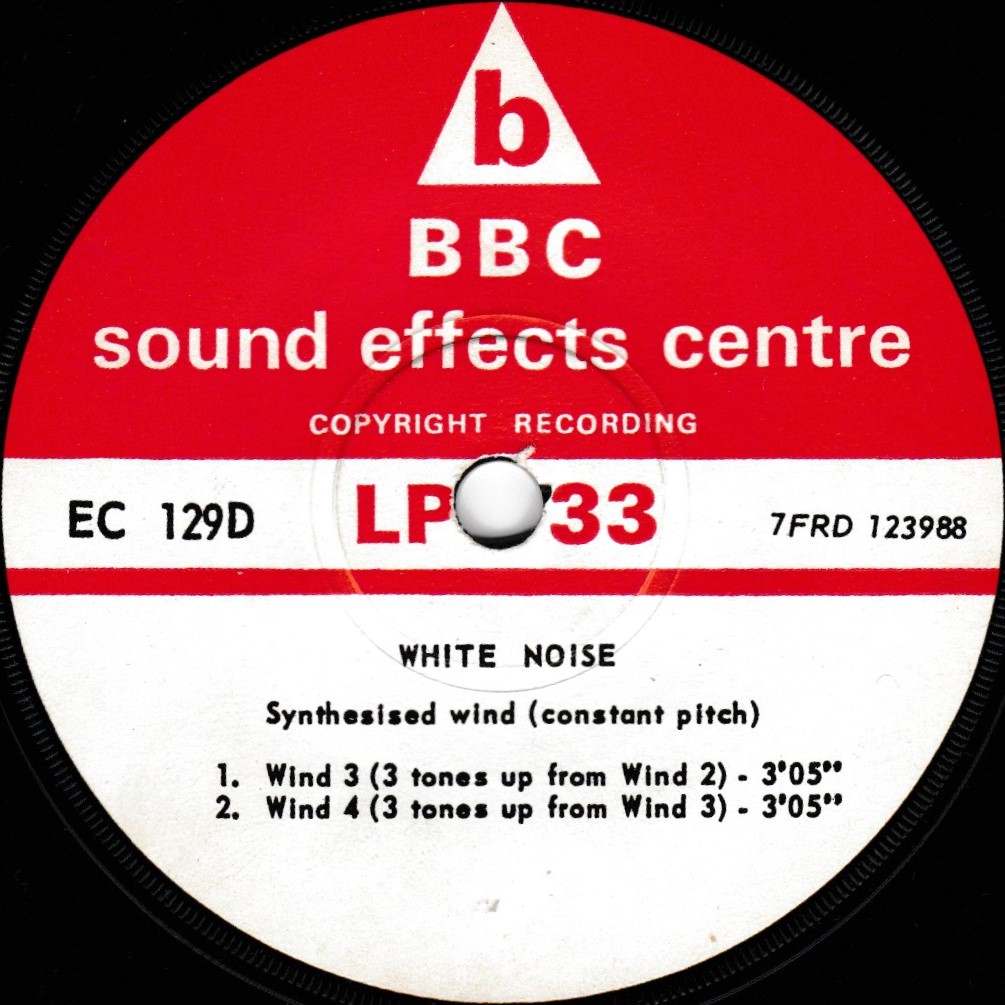
Tones – Dick Mills
‘Tones for Sound Effects Centre’ was recorded for the insatiable Harry Morriss (Organiser, Sound Effects) by Dick Mills in November 1971. This tape (TRW No. 7506) must be disc EC 192J which dates its content to December 1971. ‘Electronic Sounds: Sine Wave Tones’ comprises “Ten separate bands of sine wave tones at various frequencies”
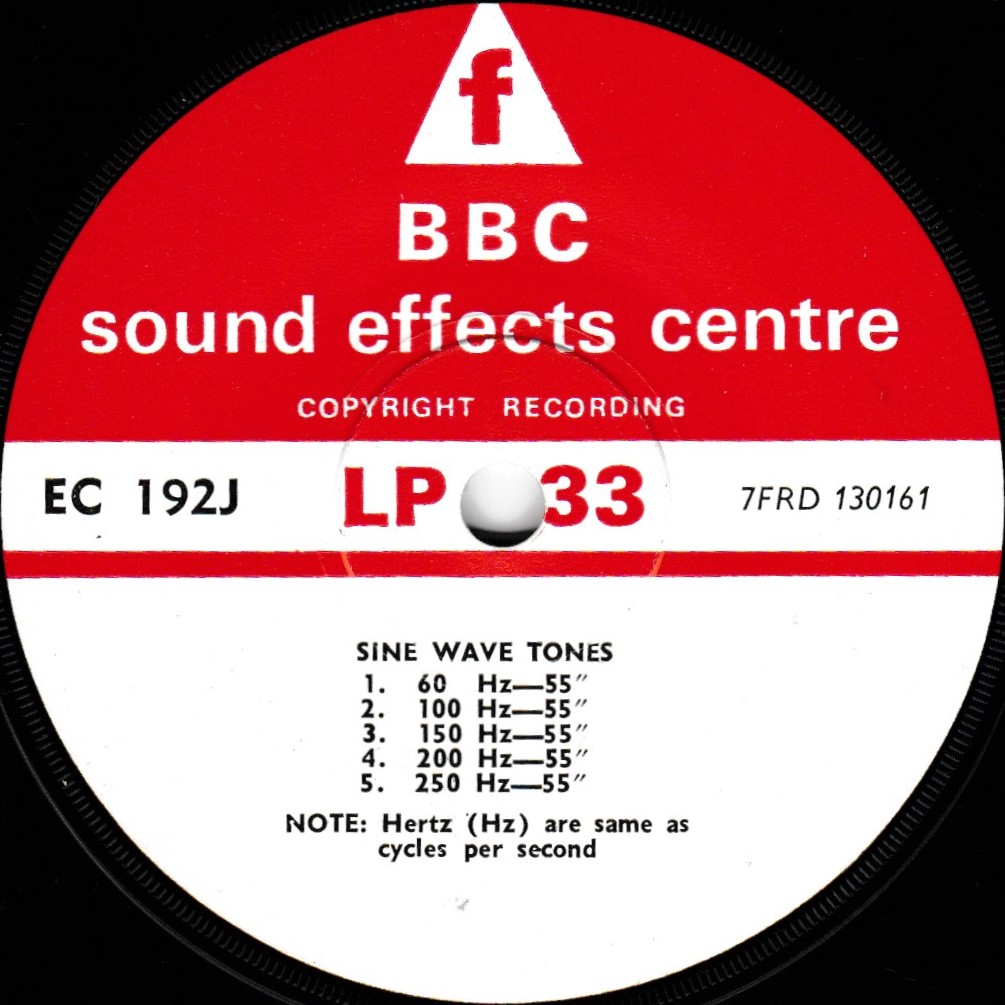
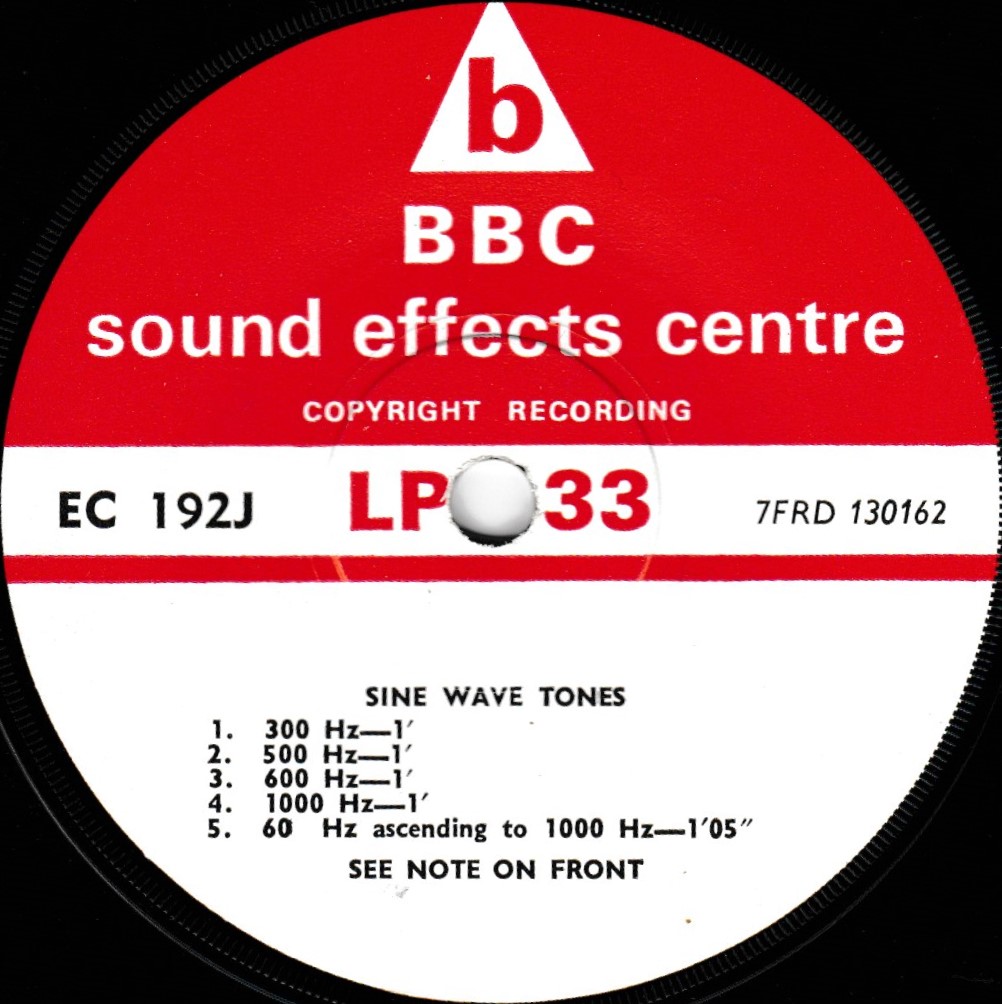
Perhaps the similar: ‘Electronic Sounds: Warble Frequencies’ on EC 192G are also from the RWS (see below). Dated May 1970, they don’t match with the ‘wobble tone’ tape (TRW No. 6023) which is dated 1963 and has no ‘composer’. Wobble would be a reference to the Wobbulator.
Not On Disc?
This section covers tapes in the RWS archive which are labelled as being for the SEC yet have no obvious disc in that catalogue. Perhaps they will be found one day.
Square Wave – Signal Generator
As you can’t actually compose a square wave there is, unsurprisingly, no composer listed for this tape. If the SEC asked for such a waveform all you had to do was turn on a signal generator, select a square wave output and record it. On the other hand, there is no square wave listed in any of the SEC catalogues. Sine waves? Yes, as we’ve seen. Warbles, hums, and just plain monotony are all covered, but if you look up ‘square wave’? Nothing. So, this tape (TRW No. 6309) listed as ‘Square Wave for Sound Effects Centre (Central Programme Operations) was recorded in May 1965, but after that, well, it’s a mystery. Market and other town and city squares are, by contrast, available in cosmopolitan abundance.
1965 is early for the SEC catalogue though. It was around this time that the switch from 12” 78 RPM to 7” 33 RPM discs was beginning. This is one effect which might be found on a 78 only, predating the SEC catalogue.
Seawash – Brian Hodgson
This tape (TRW No. 7234) is recorded in that fancy new stereo sound they have nowadays. “Stereo Seawash for Sound Effects” again for Harry Morriss (Organiser, Sound Effects). It was logged into the tape library in August 1970.
There are lots of sea sounds, in mono and stereo in the catalogue, but nothing “specially created”. Perhaps something was converted to stereo, but there’s again nothing suggested in the catalogue.
Ice Cream Jingles – Dick Mills
Here’s another one that doesn’t leap out from the SEC catalogue. Ice Cream Jingles ought to be easy to find and this tape (TRW No. 7483) was created for our old friend Harry Morris in October 1971.
Vans: Austin, Bedford and Ford are covered in great detail, but nothing playing a tune.
Turning to ‘Ice’ I find a note in the catalogue under ‘Ice cream van chimes’. It advises to “see YA section of the Sound Archives catalogue”. What the Cornetto could that mean? There are no discs listed here, but presumably, the BBC Sound Archives held (or hold) one of these chimes. Either created by Dick or perhaps just compiled from field recordings – it’s unclear – this one will require a more determined investigation.
The Sound Archives had a lot of overlap with the SEC as they both were in the business of capturing the sounds of the era. The real mystery, perhaps, is what the “YA section” is. Is that a code or an acronym?
Police Car Sound – Dick Mills
It had been a while, but in May 1973 Dick Mills logged a tape (TRW No. 7790) which was labelled ‘For sound effects dept.’ The effect is called “Police Car Sound” and was realised for Norman Bain. Pre-RWS, Bain was the collaborator of founders Daphne Oram and Desmond Briscoe, but there’s no information on his work for the SEC or any sound effects department these fifteen years later.
There’s no sound in the many police car effects of the SEC catalogue which matches this description. Nothing was ‘specially created’. I can only suppose that a very specific sound was called for and Bain called Desmond Briscoe and asked for a favour.
(Mostly) Not Radiophonic
As we’re looking at SEC discs I want to address some that appear to be, or in some cases partially are, RWS-related. Currently in my investigations, that means either comedy effects or a set of stereo electronic effects.
Comedy Effects- EC 7A-M
Back to mono for the EC 7 series. These are dated 1967 through to 1972 but in many cases are much older. They are all described as “specially created”.
One entry in this large selection is 100% certainly a Radiophonic effect. On 7K we find Radiophonic Stomach. Described in the catalogue as a “sequence of sounds including explosion, whoosh, bubbling and belch. (Specially created effect). This is the famous Major Bloodnock’s Stomach, created for The Goon Show in 1959 by Dick Mills and Jimmy Burnett.
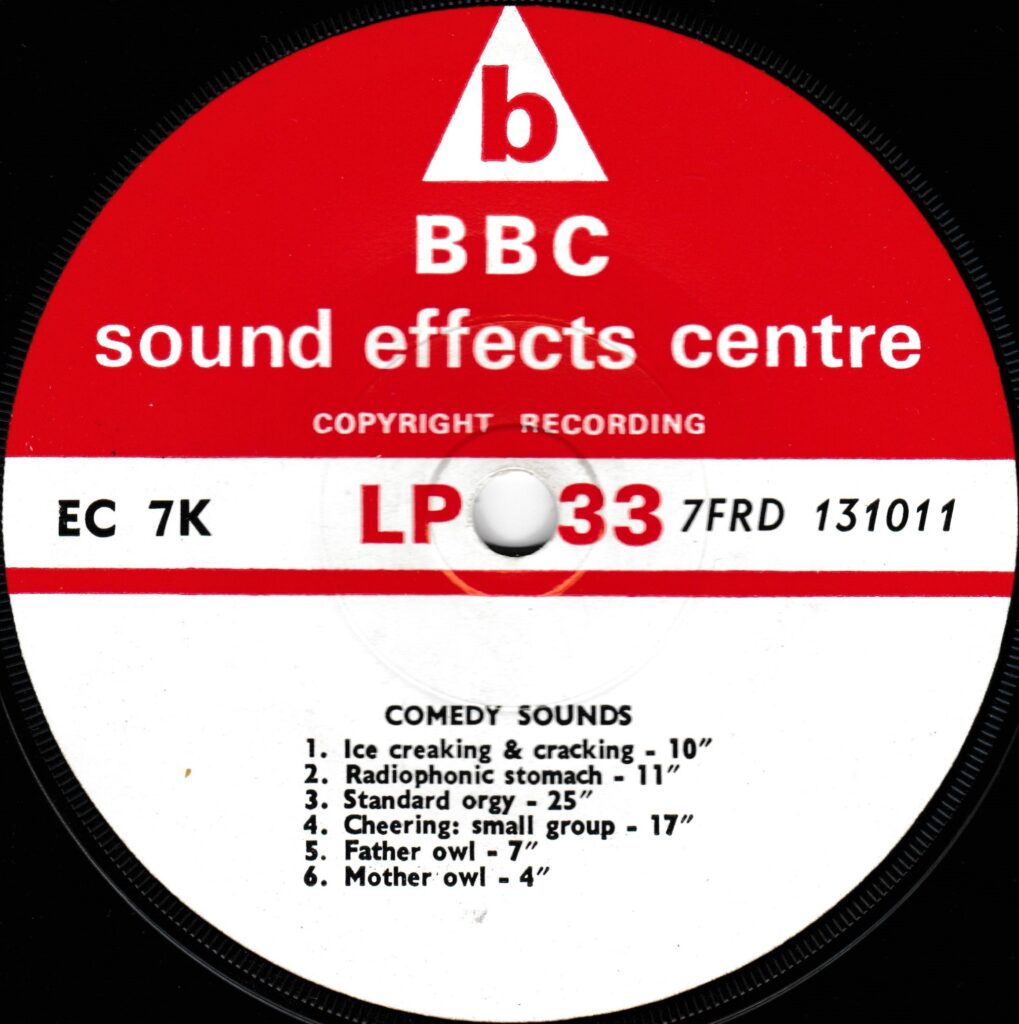
Elsewhere it’s possible to trace the effects back to the original 78RPM 12″ effects library discs. I know of at least two discs titled ‘Effects For “The Goon Show”‘. The sounds on these are all traceable to the SEC catalogue and 7” discs. As the Goons wrapped up in 1960 (thanks in part to the reluctance of the RWS’s Organiser Desmond Briscoe to support it with effects) these 12″s probably come from no later than the early sixties.
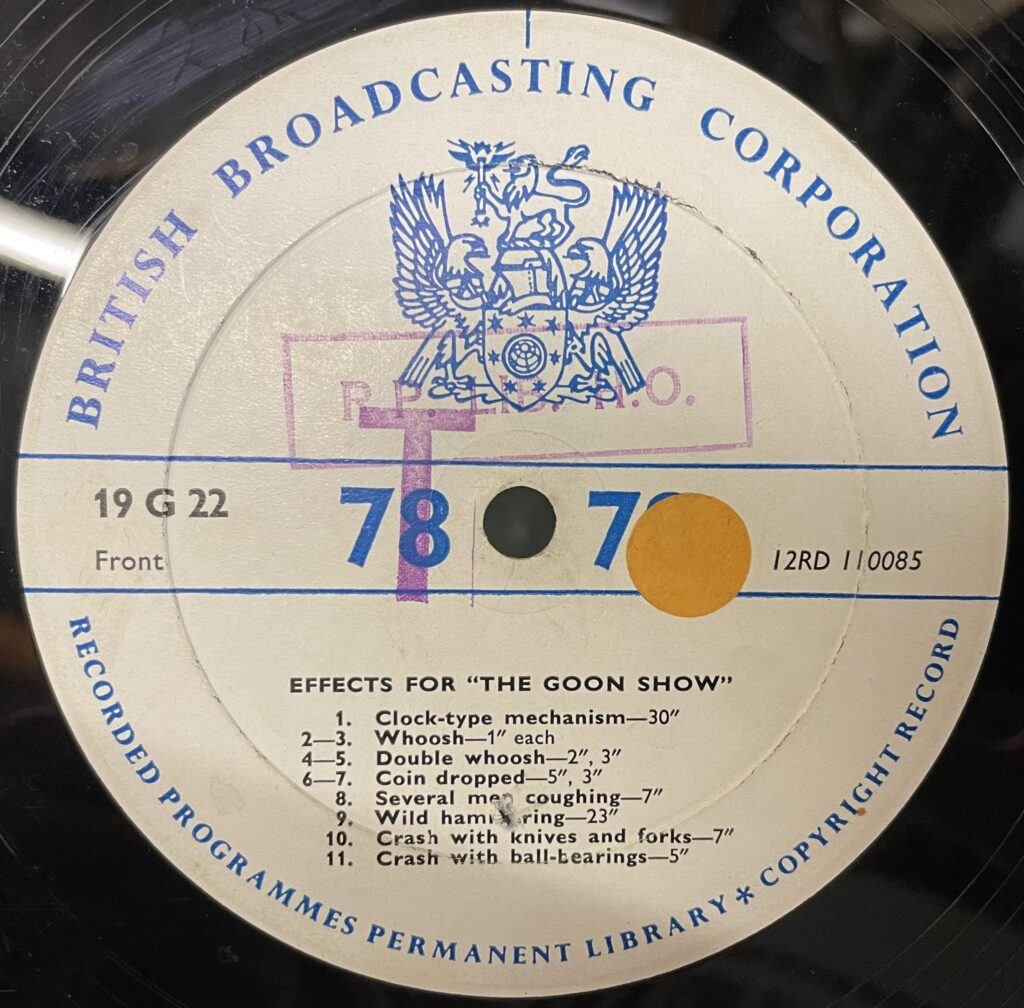
The enduring mystery is: how many effects did the RWS create for The Goon Show? This mystery and the story of the RWS on 12″ 78s is for another time, one where I can get to that kind of info.
Electronic Sounds – ECS 5Es
Back into the stereo era now with a selection from the Electronic Sounds category. ECS 5E discs run 1-9 with a plethora of effects created from 1980 to 1985. Most of these are “specially created” and could at first sight and hearing all be from the RWS. Not so!
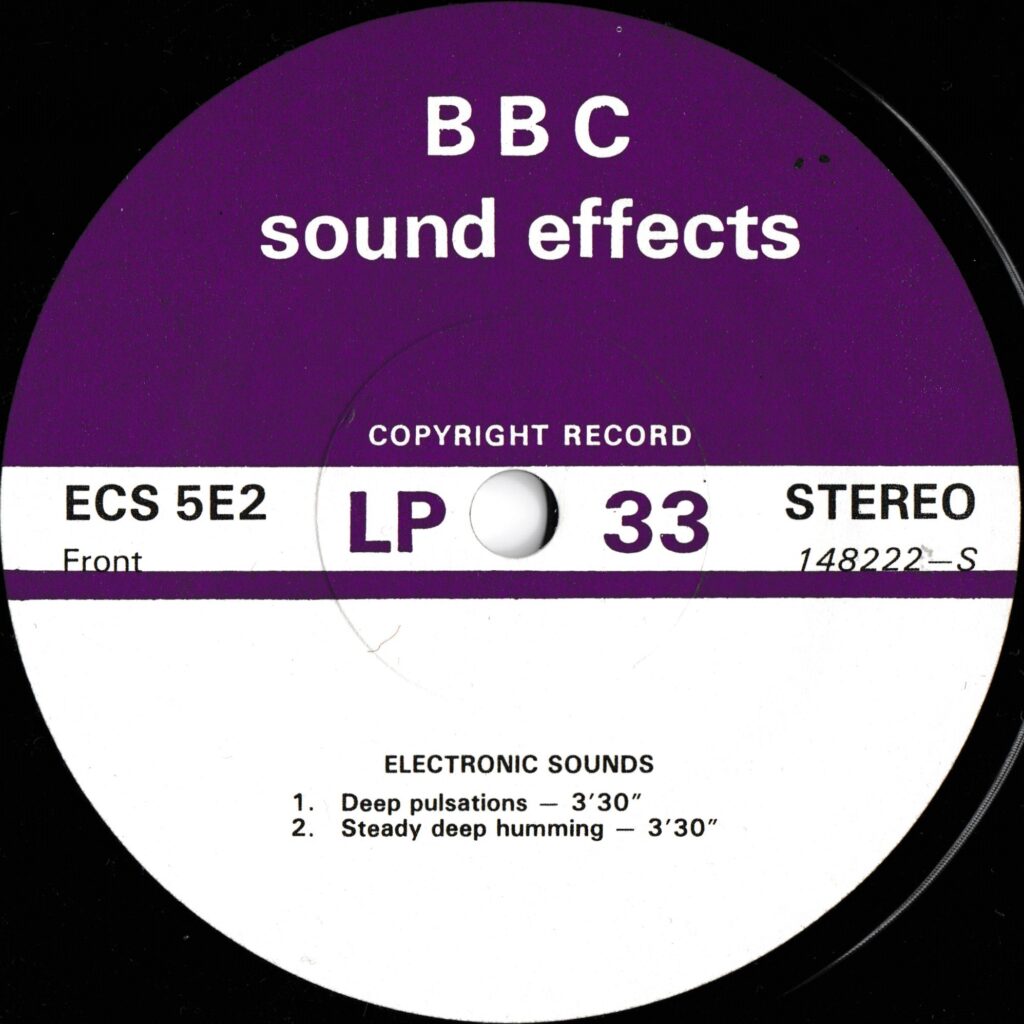
Electronic Sounds – ECS 5E1-5 – 1980
You’d be forgiven for assuming this selection was the work of the RWS. Laser guns, hums, pulsations, automatic doors, bleeps and all manner of computer-y business. This lot has to have come from some science fiction show or shows that passed through the doors of Maida Vale, surely! Before I reveal the facts, let’s just work this through.
Moving just past the dates for these effects there is BBC Sound Effects no.26 – Sci-Fi Sound Effects (REC 420,1981). This compilation from William Grierson contains effects from Doctor Who, Blake’s7, The Hitch-hiker’s Guide To The Galaxy, all RWS, and Earthsearch. The latter is a lesser-known Radio 4 serial first broadcast in early 1981 whose effects are credited to Lloyd Silverthorne. Silverthorne was at the RWS in the early seventies but by this time he was operating as a kind of in-house Radiophonic Workshop for BBC Radio. He’s often credited with ‘Technical Presentation”, which is fancy way of describing specially created sound effects. Given how busy the RWS was in 1980 with the other three shows it’s not surprising that such a glut of sci-fi shows hitting the airwaves at the time meant that they couldn’t squeeze in another show.
And it’s this production which provides some documentary evidence of the provenance of these SEC discs. In the BBC Enterprises file held on the ‘Sci-Fi Sound Effects’ (REC 420, 1981) LP, a correspondence between Grierson and Lloyd Silverthorne confirms that the Earthsearch effects selected were “in library”. Grierson sends a list to Silverthorne suggesting the effects he wants to use for the LP with references to the effects from the ECS 5E discs 1, 2, 3, 4 and 5.

That’s not quite the whole story. More effects are used than he proposed, but this is the story of the SEC discs, not the Sci-Fi Sound Effects LP. The point is that the Earthsearch part of the LP was based on entirely these discs.
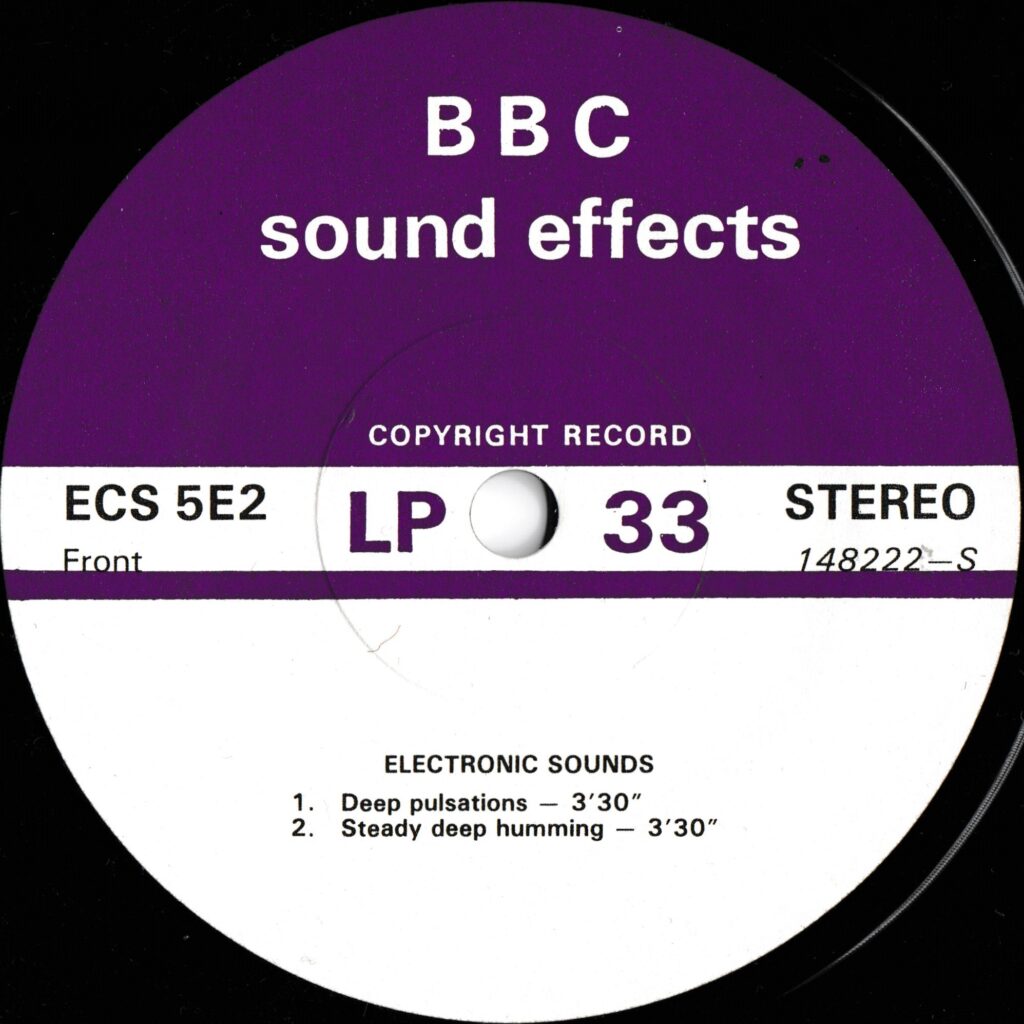
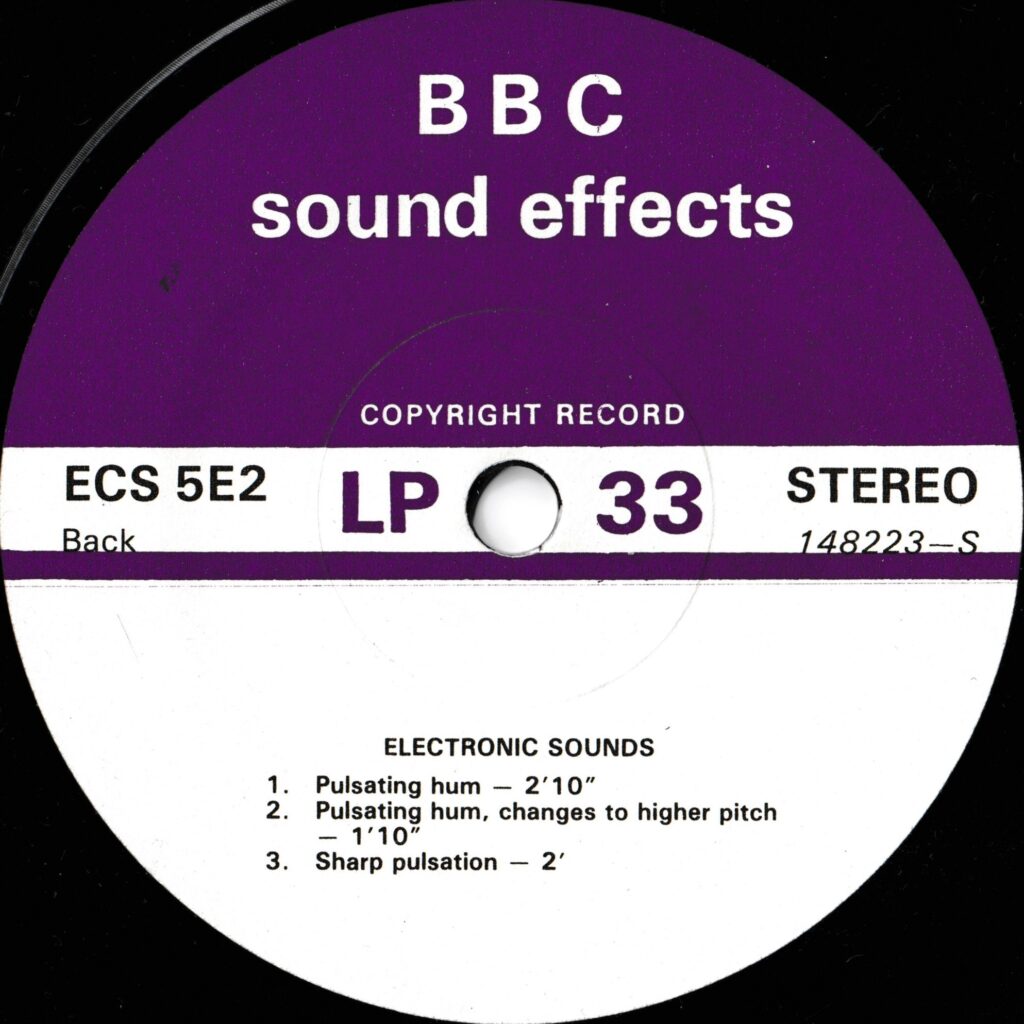
This was initiated in March 1981, so BBC Records and indeed the SEC were very quick off the mark. The broadcasting of the first series of Earth Search had only just finished in February. The effects seem to have been cut to the discs and distributed before the show had even been heard to the end.
This may have been almost too hasty. The show was pushed out late at night and may have done slightly better than expected. It was later repeated in the daytime after a favourable listener response. The SEC would want generic effects and nothing too recognisable so they may have chosen this series with that in mind. Especially compared to the RWS shows which were hugely popular. Inclusion on the BBC Records LP may have further watered down the exclusivity of the sounds on their premium catalogue, not that it seemed to prevent them.
As the Sci-Fi Sound Effects LP sold very well and was reissued on CD a couple of times it’s not hard to compare with the sounds on BBC Rewind and confirm for yourselves what I found in the BBC files.
Electronic Sounds – ECS 5E6-8 – 1982
Looking at this selection and the date, 1982, it seems likely that these effects came from Earthsearch series 2. That said. There are some field recordings on 5E8. A Pelican crossing and a mono recording of a Space Invaders game.
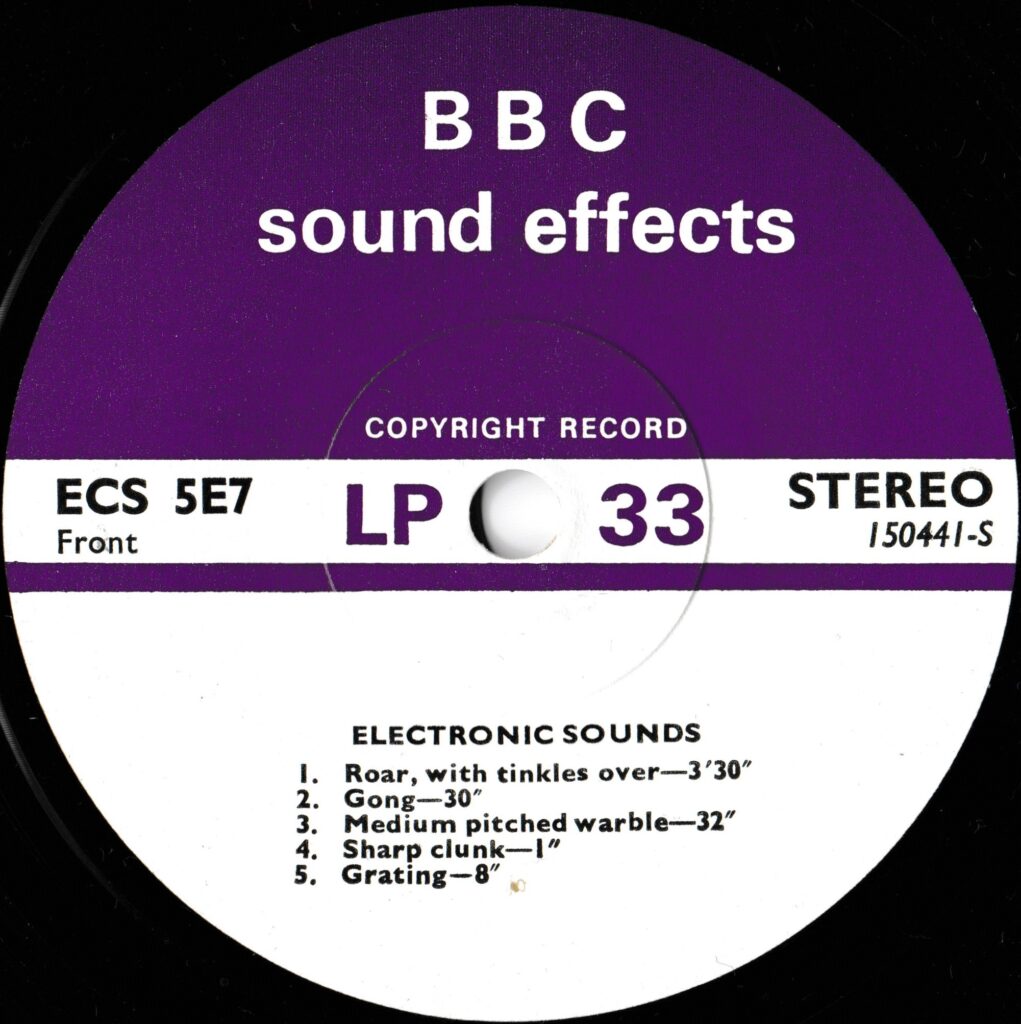
In the present day Discogs user Etron81 removes any further doubt stating confidently that:
Track A1 here is the opening theme of the second season of “Earthsearch”.
https://www.discogs.com/release/20511499-No-Artist-Electronic-Sounds
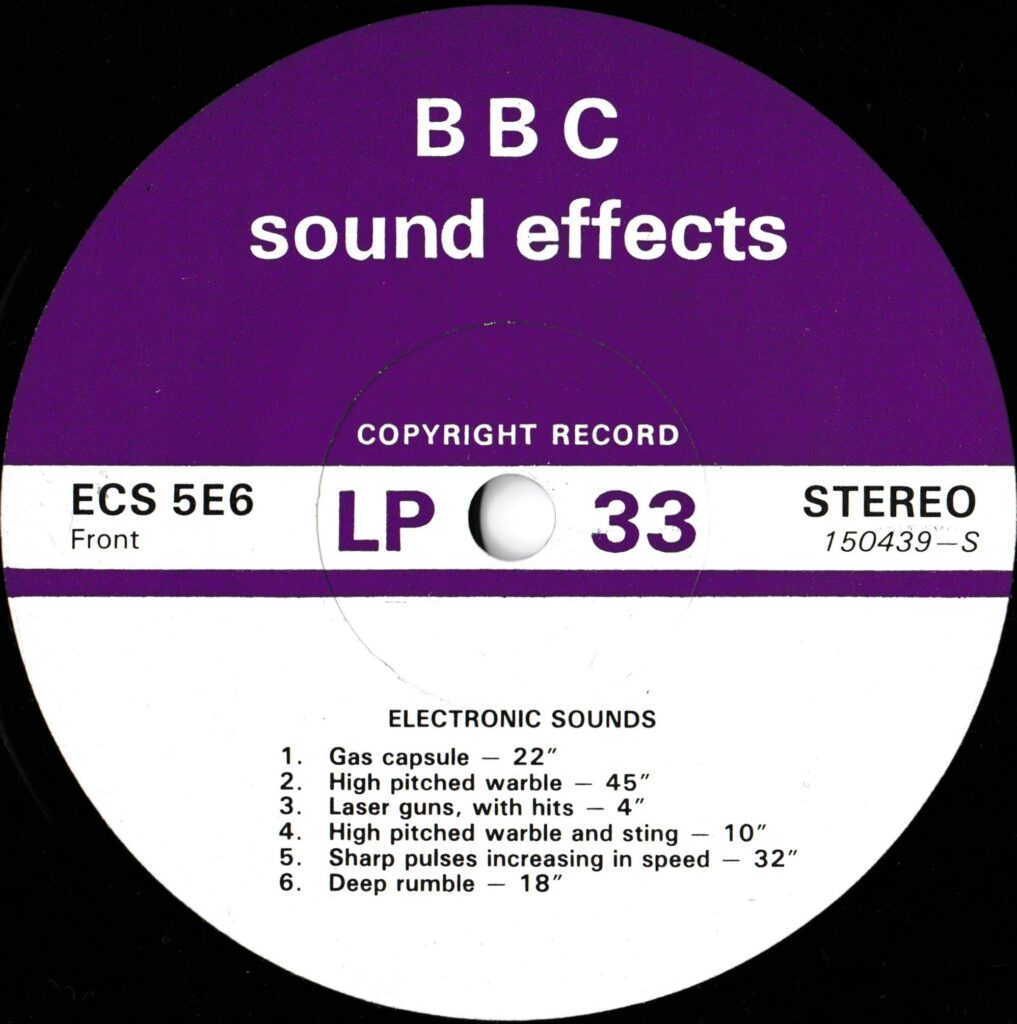
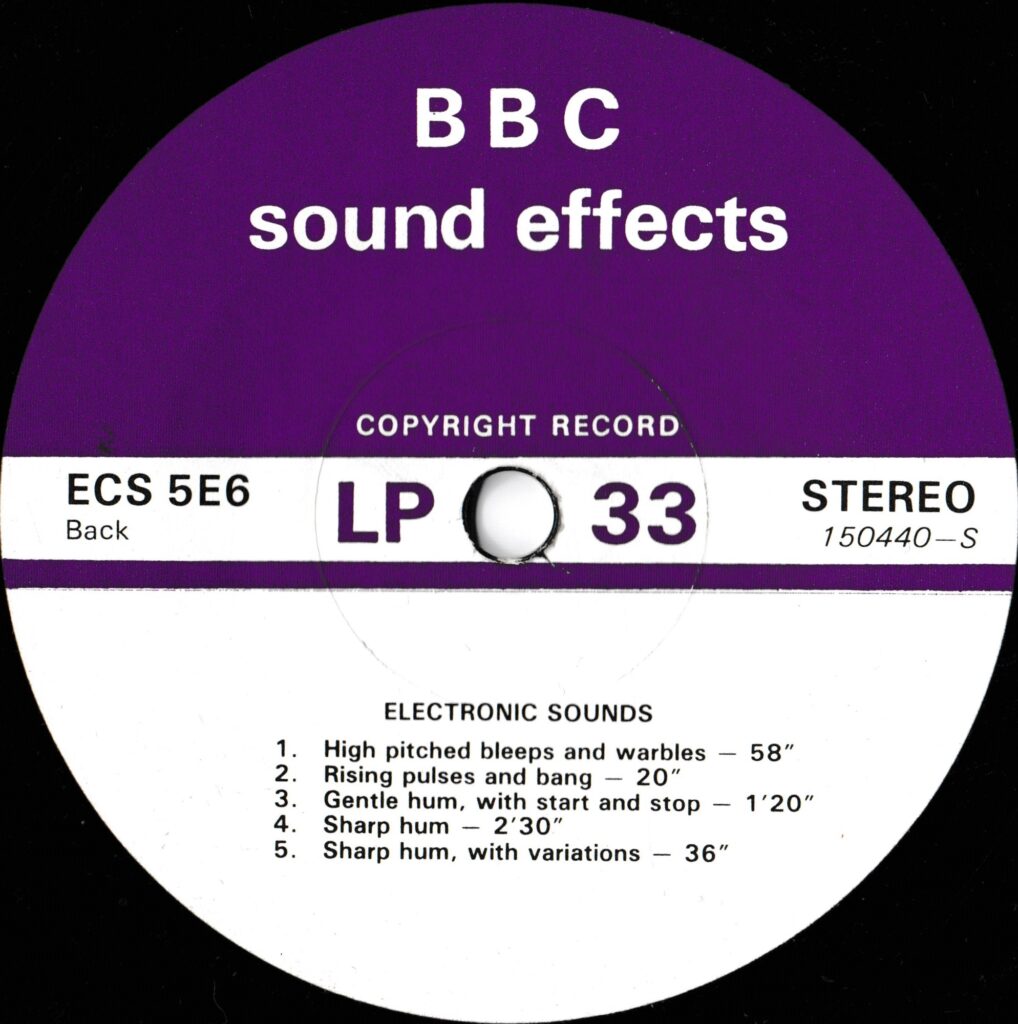
These effects were not later released by BBC Records, and so they enjoy a more exclusive presence on these SEC discs.
Electronic Sounds – ECS 5E9 – 1985
The final Electronic Sounds disc in the 5E series is number 9. Dated 1985 it doesn’t make it into the catalogue for that year. These effects are recordings of the ‘Apricot portable microcomputer (1985 model.)’ There’s no need for this to come from the RWS and no evidence that it does.
The BBC Record’s final sound effects LP was no.29, ‘Hi-Tech FX’ (REC 531, 1984). That includes plentiful effects of a similar nature. As that was released in 1984, and we know the migration for effects is from SEC to BBC Records and not the other way, we can discount that as a source.
Speculation Section
And so we come to the realm of conjecture.
Army Movements – EC 129C
Joining the gap between EC 129 A & B (sea effects) and 129 D, E & F (simulated wind) EC 129C is listed in the SEC catalogue under ‘Army Movements’
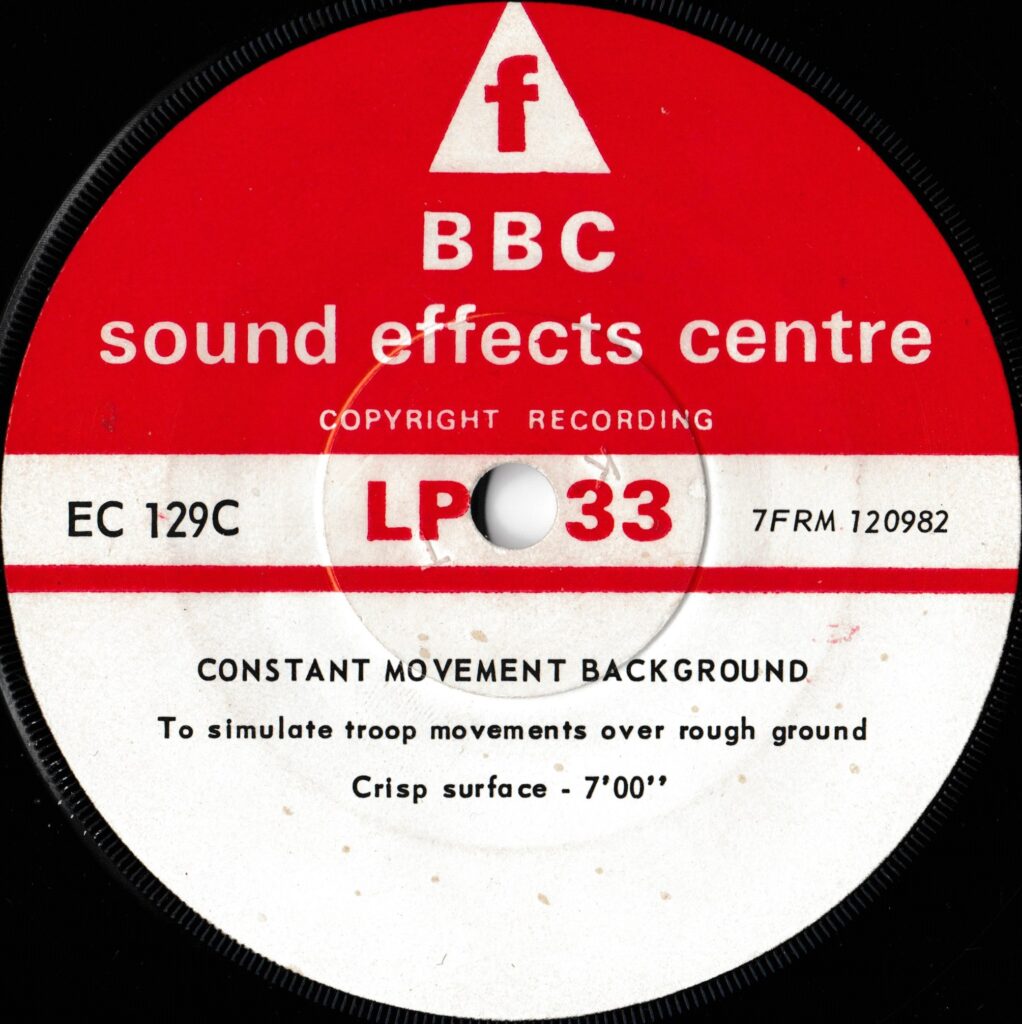
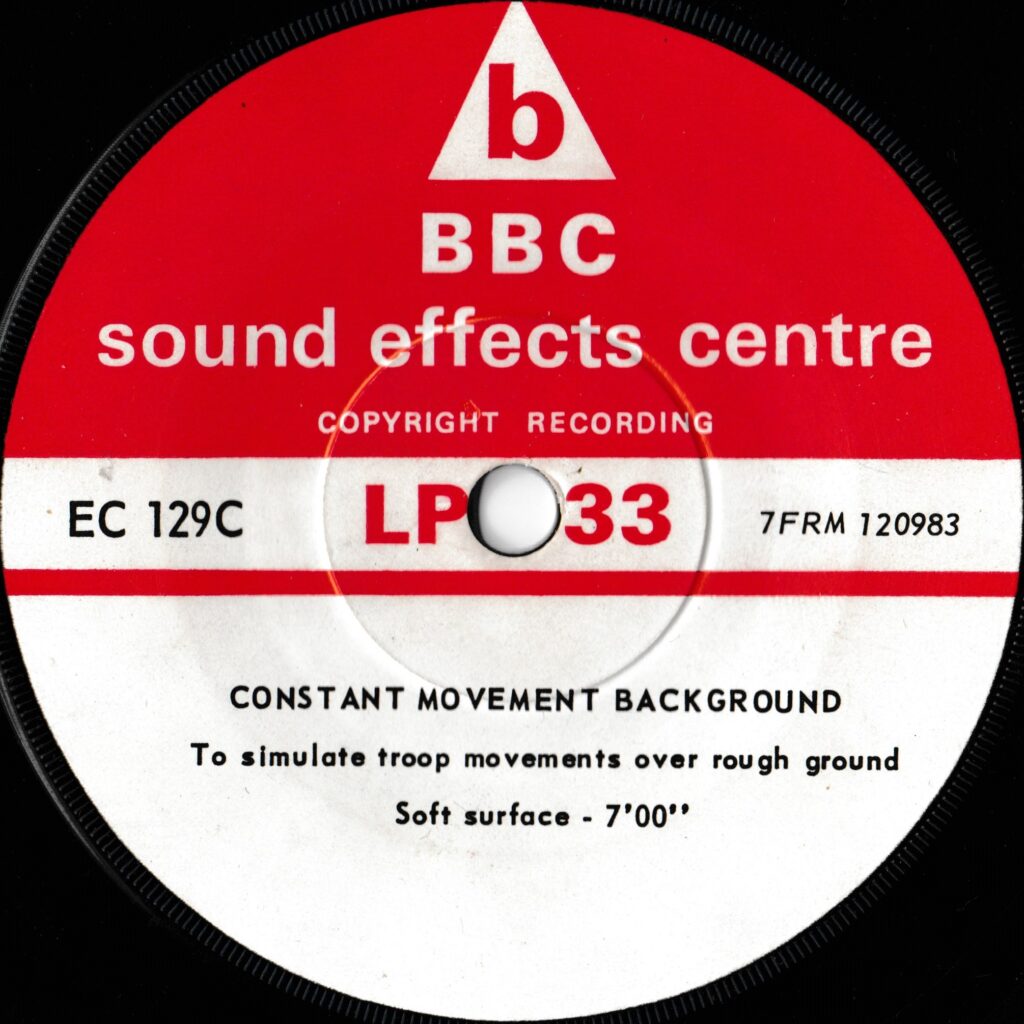
- Constant movement background on a crisp surface. (specially created to simulate troop movements over rough ground)
- Constant movement on a soft surface. (specially created to simulate troop movements over rough ground)
Both specially created sounds in the same disc number set as two pretty much confirmed RWS effects and dated September 1967? Could they be RWS too?
It might just be that these come from ‘It Was a Solid Killing Match’ (TRW No. 6718) for Ray Colley and N. Matthews, recorded September 1967. That would mean it’s by Delia Derbyshire. The tape is missing from the BBC archive. Clips of IWASKM are available here though: https://wikidelia.net/wiki/It_was_a_Solid_Killing_Match
Electronic Monotony
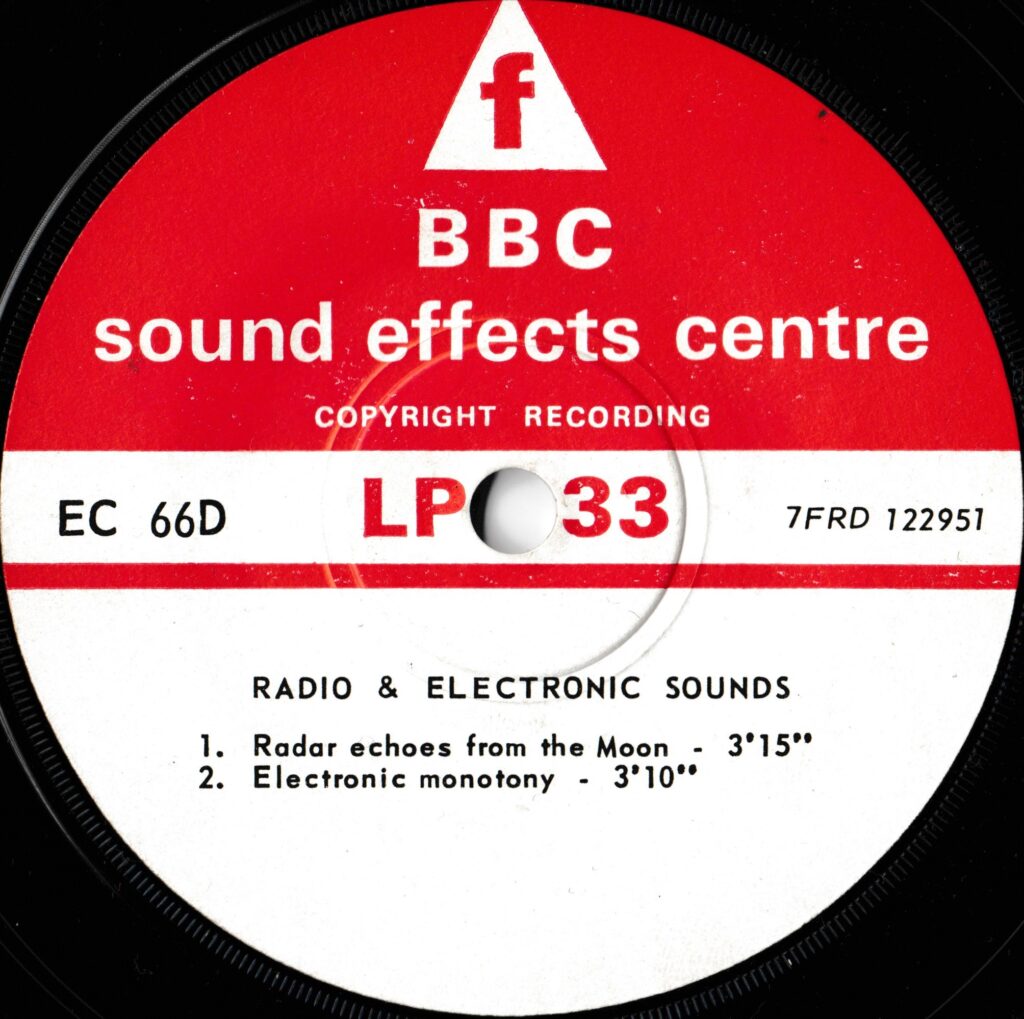
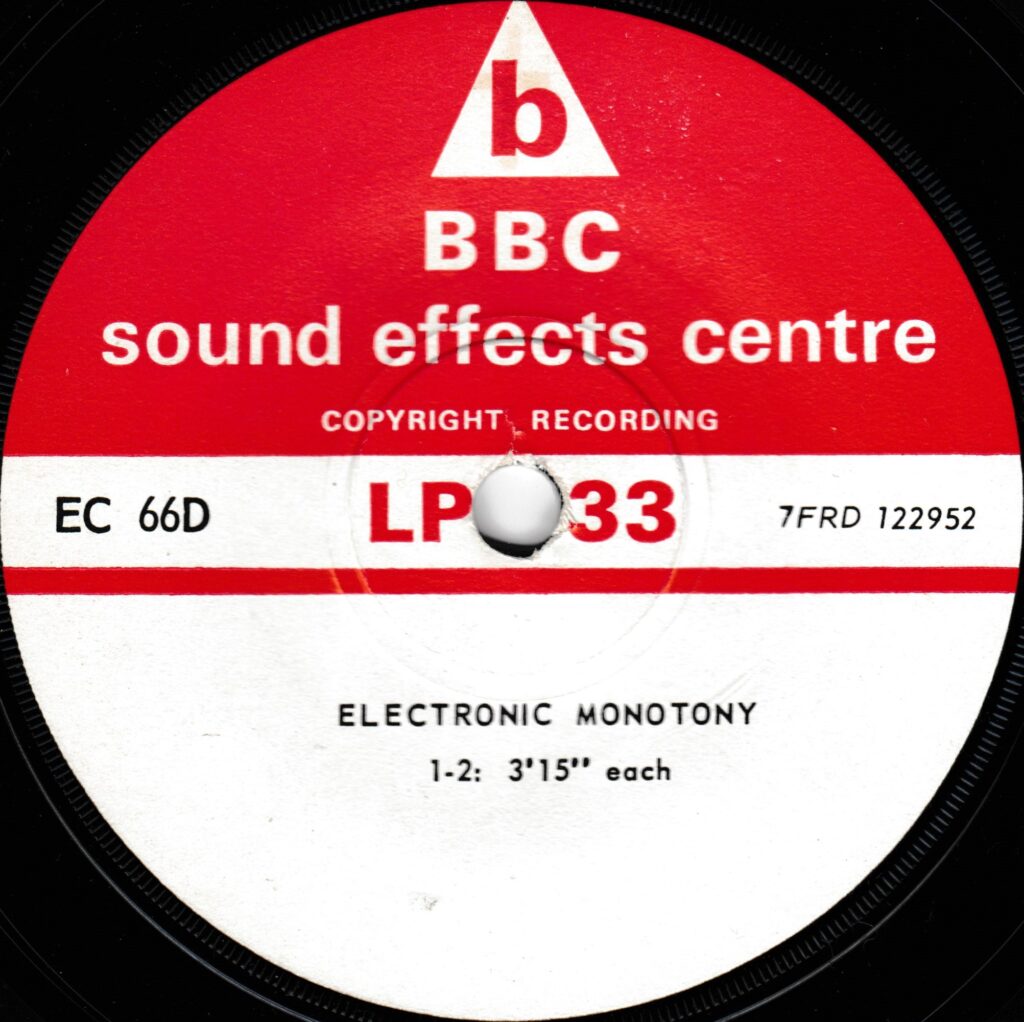
EC 66D starts with a field recording – if bouncing radar off the moon is your field. The next three tracks are titled ‘Electronic Monotony’ and are over three minutes each.
At the time of writing the BBC Sound Effects website has these sounds in a bit of a muddle, with seven in all (meaning duplicates) and the moon radar one is mislabeled with another effect. If they fix this later, the links below might break
It’s always nice to find one of these effects in use. The monotony on the front side of 66F will be familiar to fans of Crime Files from the Bob Mortimer & Andy Dawson podcast Athletico Mince. You can check it out here: https://youtu.be/TnmH9JsfZJU (NSFW!)
In terms of speculation, and where these sounds might have come from, there are many possibilities in the tape library for late 1968. There’s something about the obvious use of tape feedback in these effects that suggest Brian Hodgson’s work to me. Listen to his work on Doctor Who: The Krotons (SILLP1371) for similar background sounds.
On the other hand, you can’t rule Dick Mills out of this and he had been busy with SEC tapes in the same period.
Warble Frequency Notes
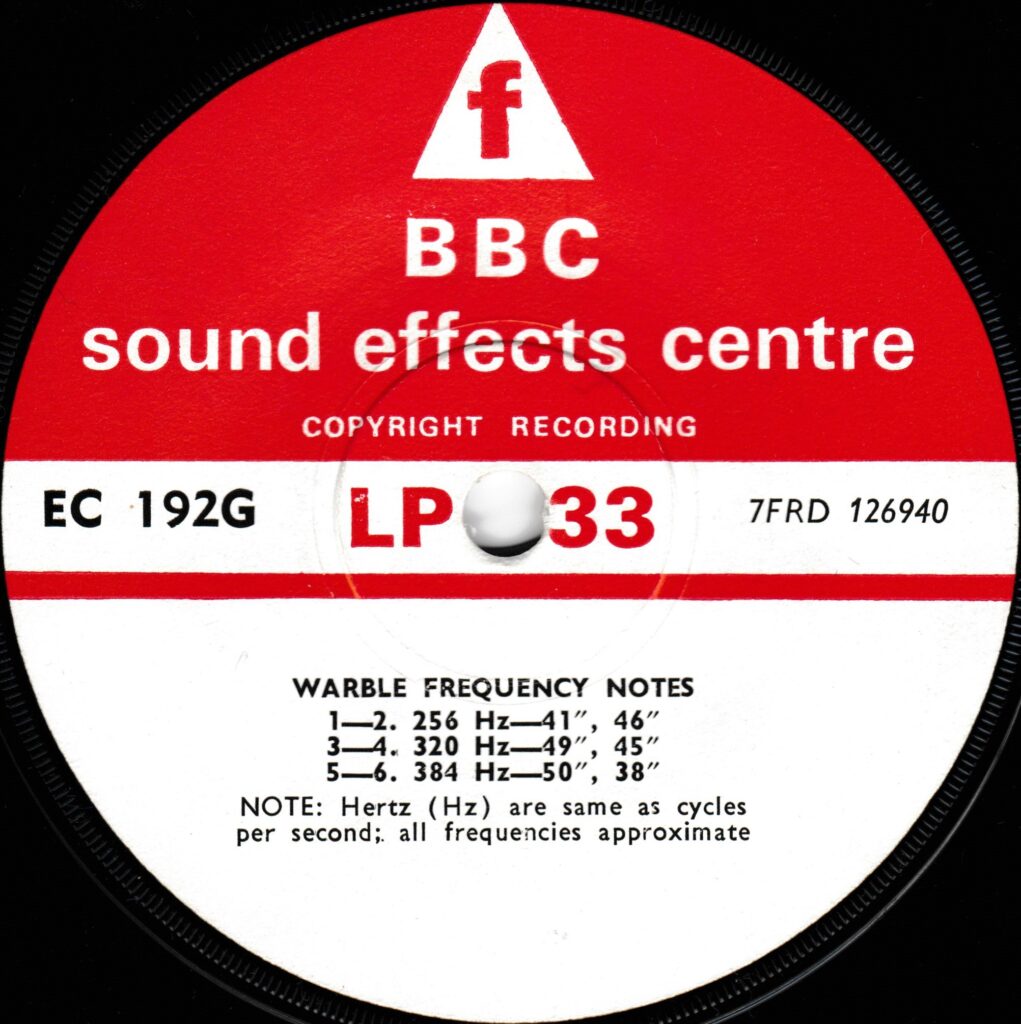
Two discs of electronic tones, EC 129G & 192H, but are they Rafiophonic? Similar to the Sine Wave Tones (EC 192J) these are arranged as a list of frequencies, albeit approximately. There are two variations of each frequency and that the ‘warbling’ refers to modulations added to the base (or carrier) tones. These tones are actually called ‘notes’, indicating musical tuning. 192G certainly are close, with 440Hz being spot on.
- 256 Hz
- 320 Hz
- 384 Hz
- 440 Hz (A4 = 440 Hz)
- 480 Hz
- 60 Hz
They are not static either. There are subtle tweaks occurring that alter the modulations/warbling.
Unlike many of the other SEC 7″ discs, which appear on the BBC Rewind Sound Effects and Pro Sound Effects sites, these ones are not referenced in the PSE spreadsheet. Instead, the effects appear on a curious set of CDs which are simply numbered ‘CD55nnn’I have yet to see any physical evidence of these and suspect they were from the BBC Archive, not those sold by BBC Enterprises. Another story…
Moreover, these effects are named with the prefix ‘BBC Historical’. This implies the recordings date back to the 78s era, although it might just mean they weren’t available on CD. Also, many the SEC effects are listed as “from 78 r.p.m. disc”, but not these.
Coming at this from another angle, if these were culled from 78s it doesn’t explain why the SWC catalogue dates them as May 1970. It would perhaps exclude them from the differently-dated ‘tones’ tape I tracked down, though (see above).
The fact that they come as pairs is interesting, I think. That might mean they were stereo, or intended as such, and could be recombined from the two mono tracks. Or, does it provide some other clue?
In the end I can’t link these warbles to the RWS yet. Time may reveal all though.
Table of RWS SEC Discs
This table is ordered by the SEC 7″ disc matrix numbers (f, front/ back, b). I’ve excluded the definitely non-Radiophonic discs and tapes I couldn’t tie to a disc.
| front | b | Disc No. | Titles | Year | Composer | |
|---|---|---|---|---|---|---|
| 117334 | /5 | 19E | Thunder | 67 | Mills | 6701 |
| 118368 | /9 | 82C | Period Battle (11th C) | 66 | Derbyshire | 6557 |
| 120628 | /9 | 129A | White Noise – Sea Effects | 67 | Cain | 6688 |
| 120630 | /1 | 129B | White Noise – Sea Effects | 67 | Cain | 6688 |
| 120982 | /3 | 129C | Constant Movement | 67 | Derbyshire | 6718 |
| 122951 | /2 | 66D | Radio & Electronic Sounds / Monotony | 68 | ?? | ?? |
| 123987 | /8 | 129D | White Noise – Synthesized Wind | 68 | Mills | 6963 |
| 125820 | /1 | 66F | Electrical Radiation – Lightning | 68 | Mills | 6951 |
| 126940 | /1 | 192G | Warble Frequency Notes | 70 | ?? | – |
| 126942 | /3 | 192H | Warble Frequency Notes | 70 | ?? | – |
| 130161 | /2 | 192J | Sine Wave Tones | 71 | Mills | 7506 |
